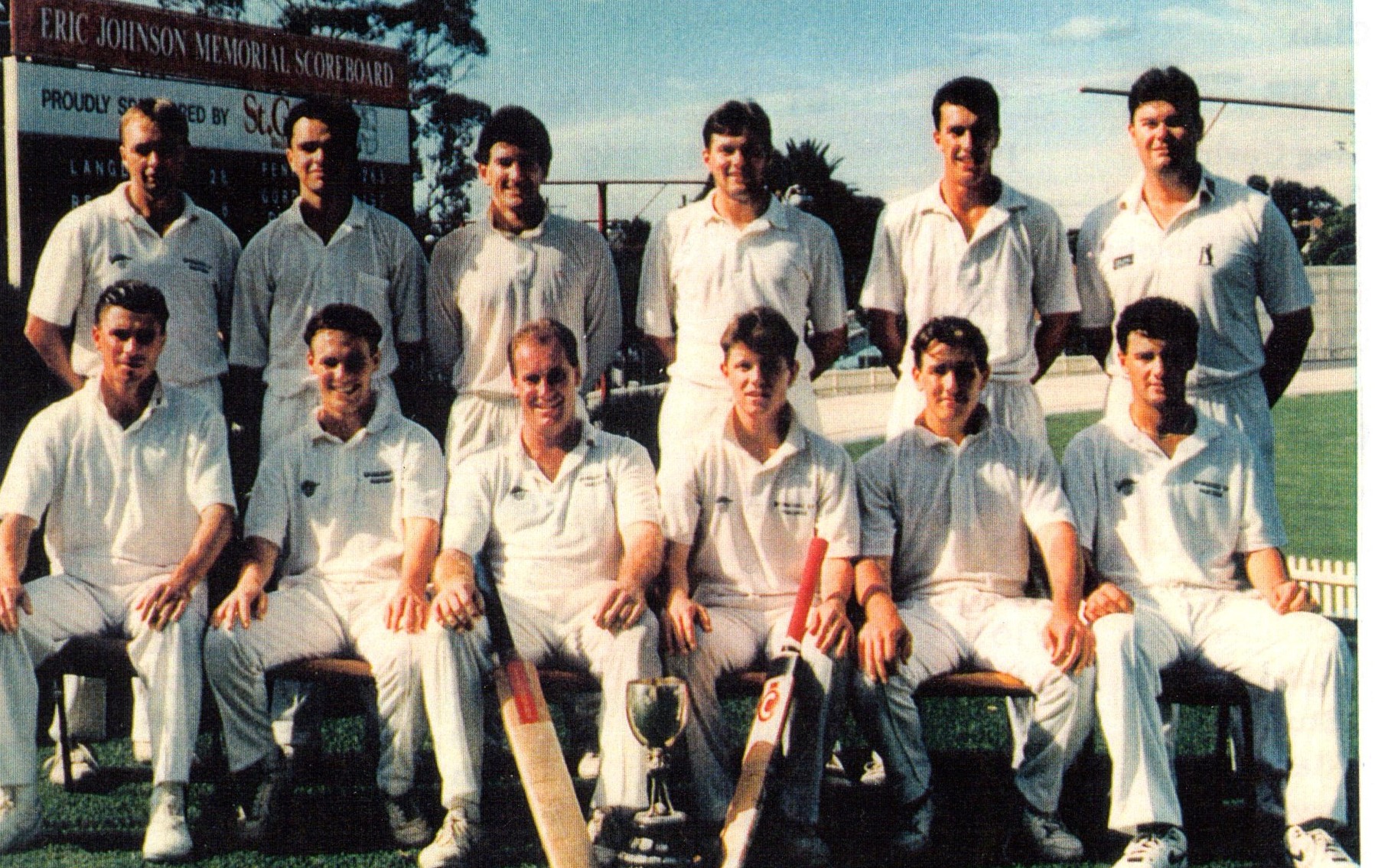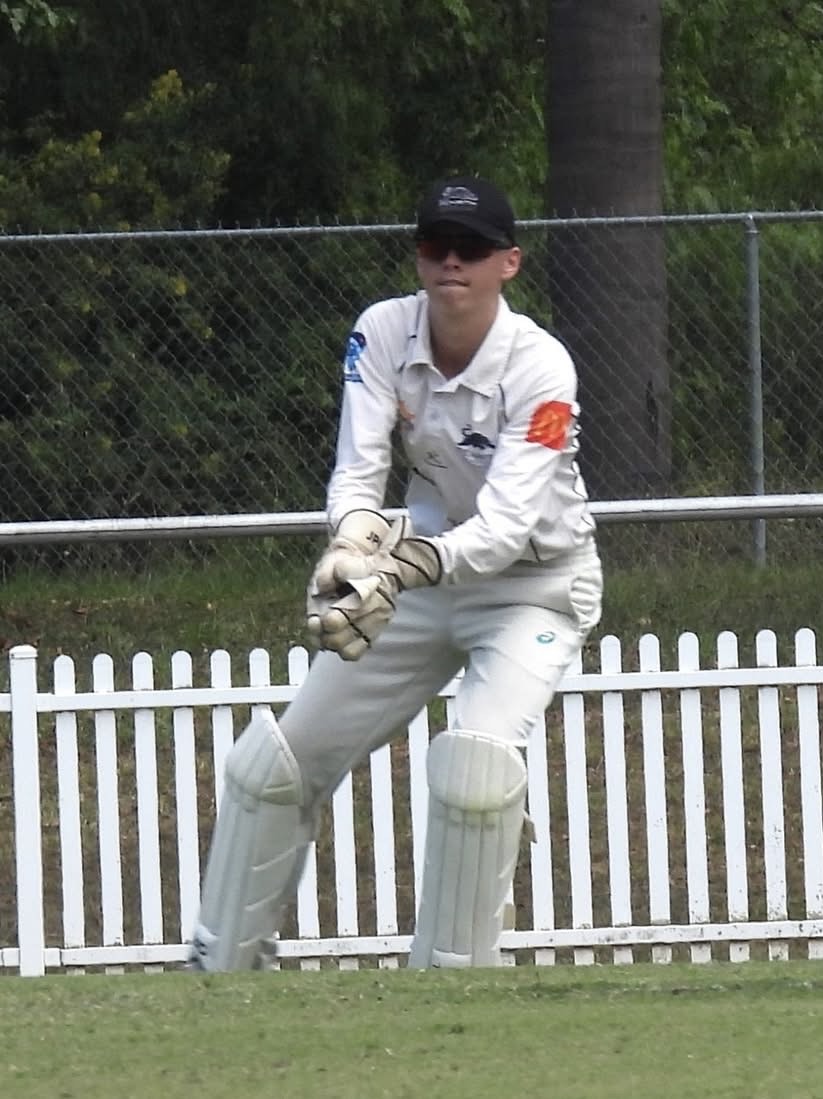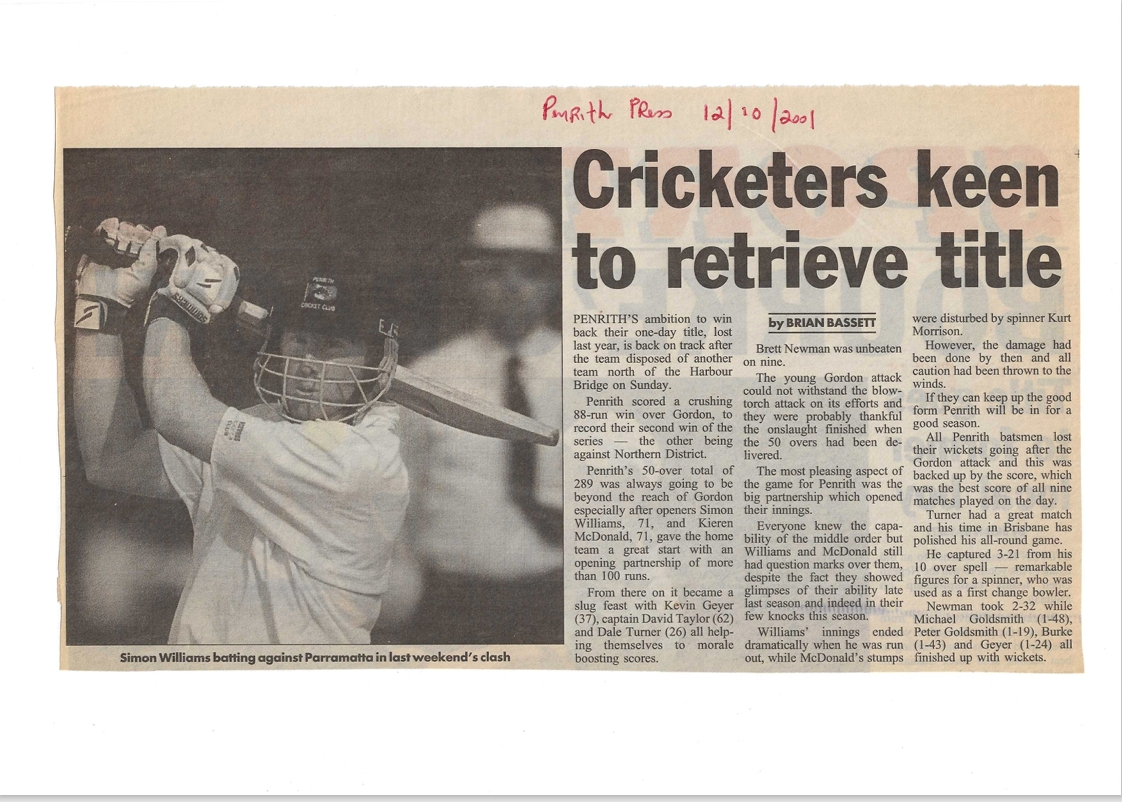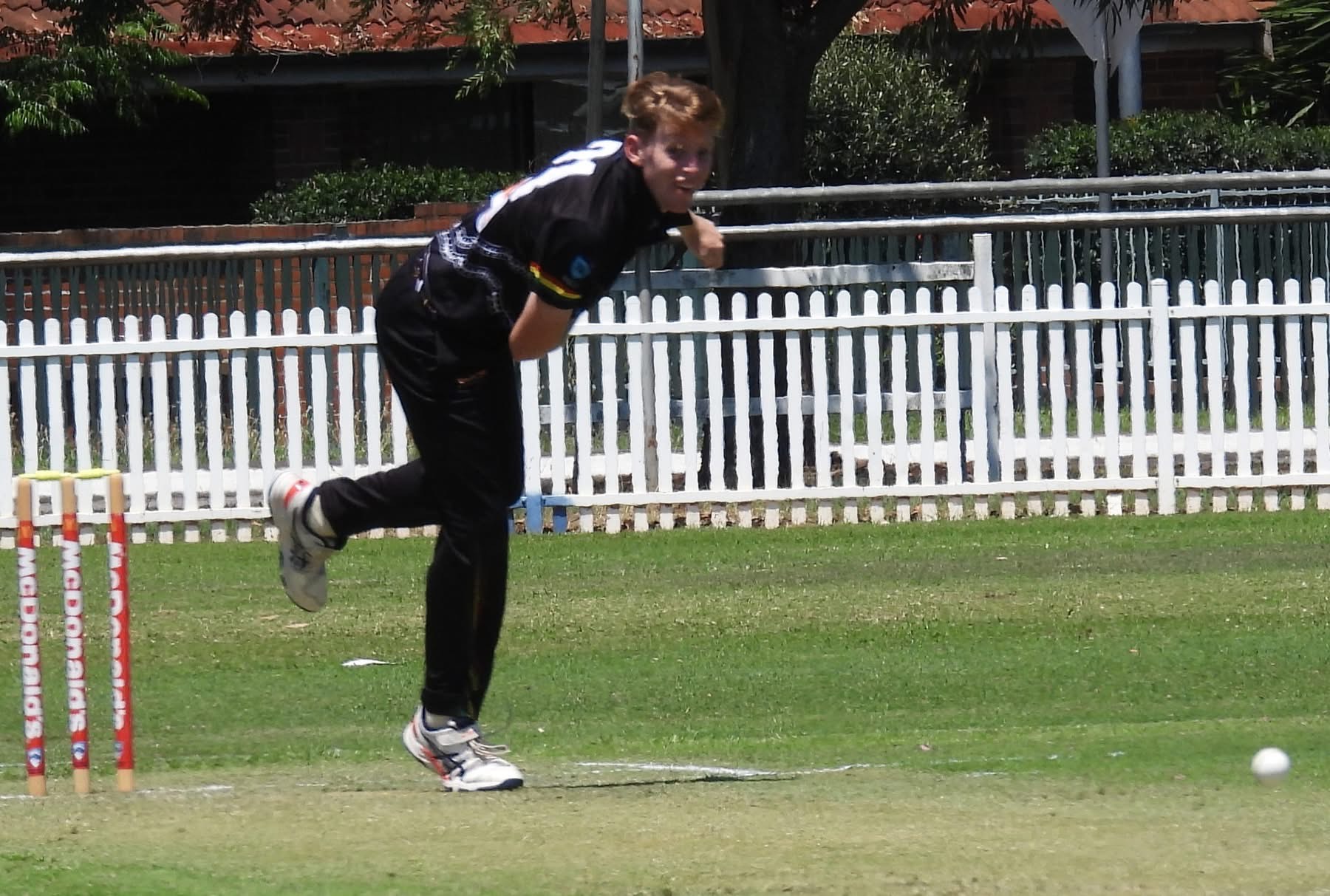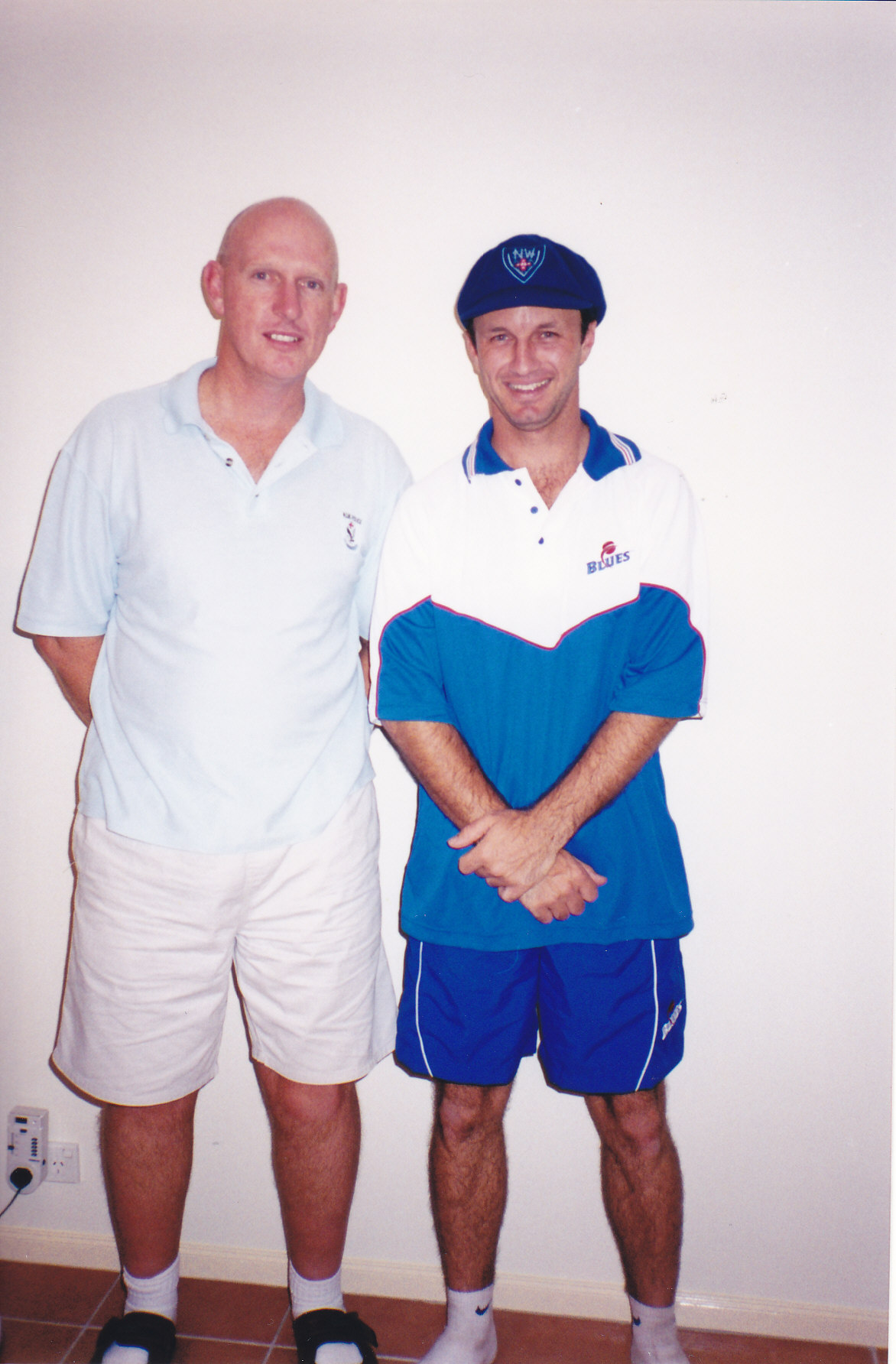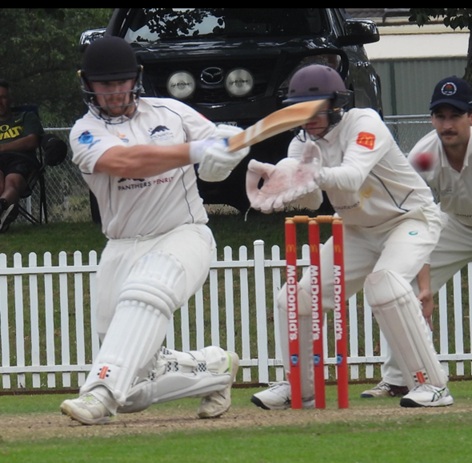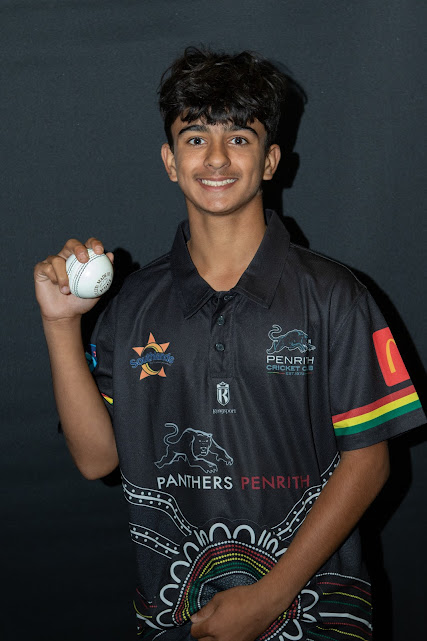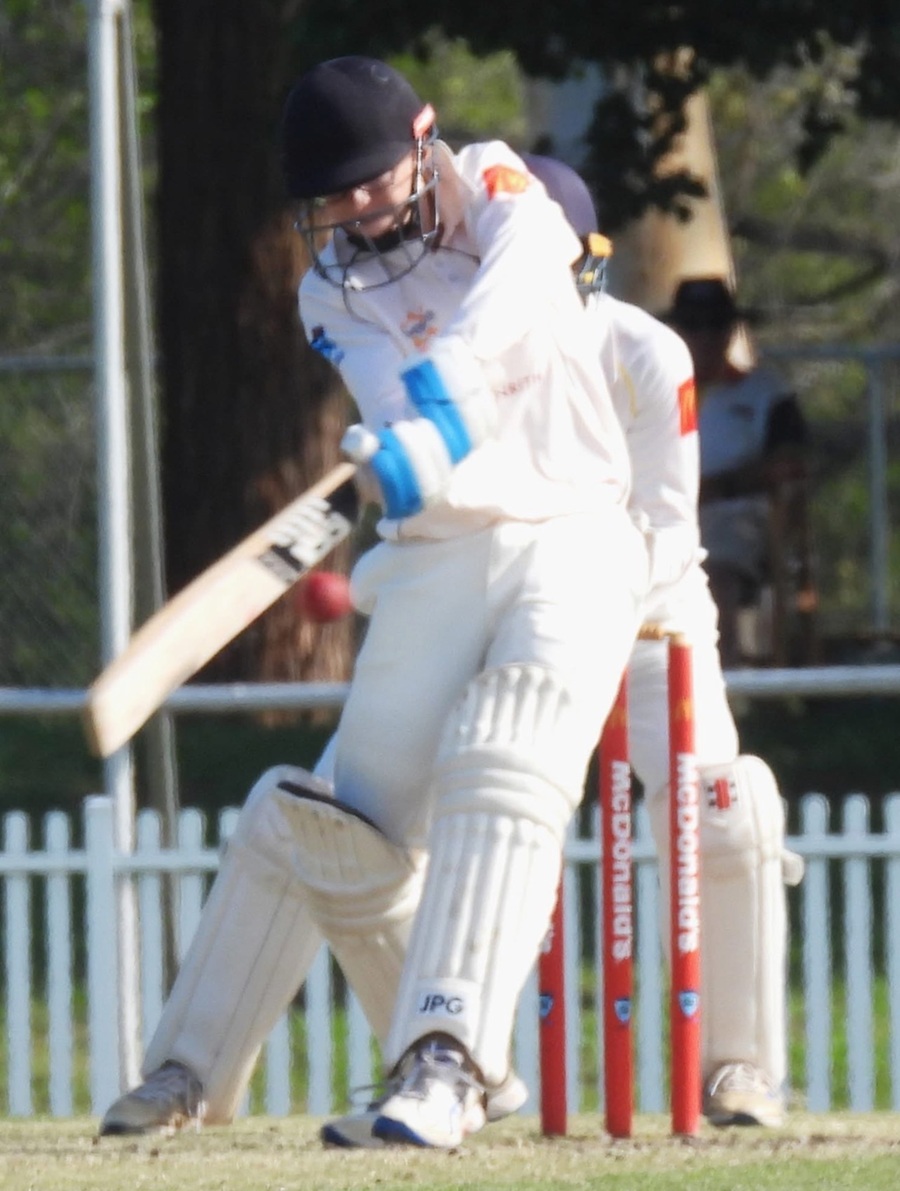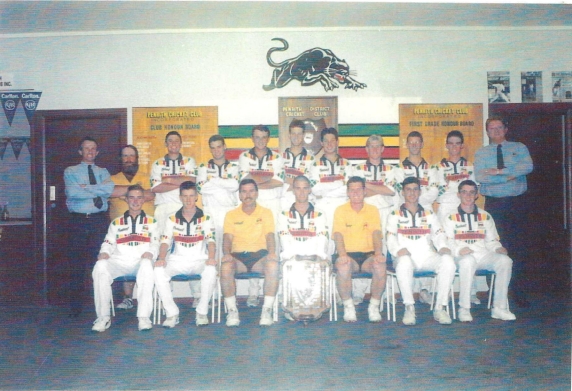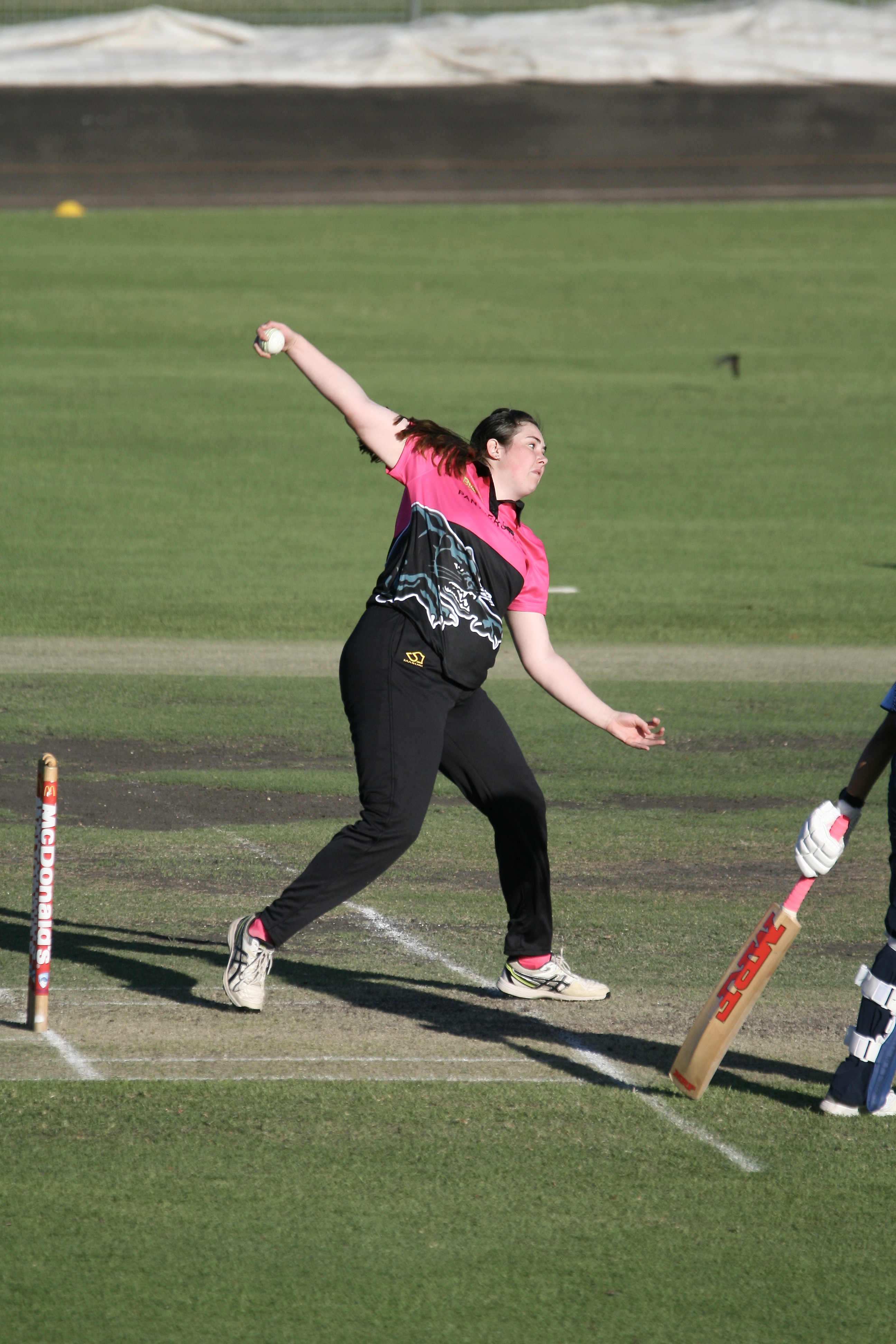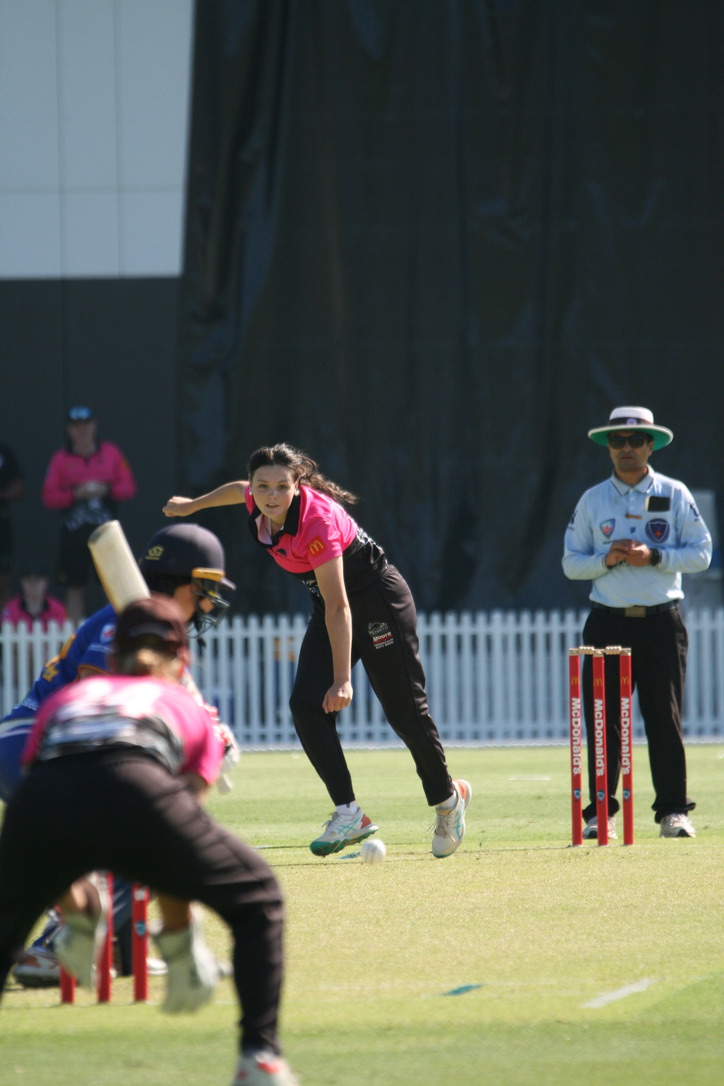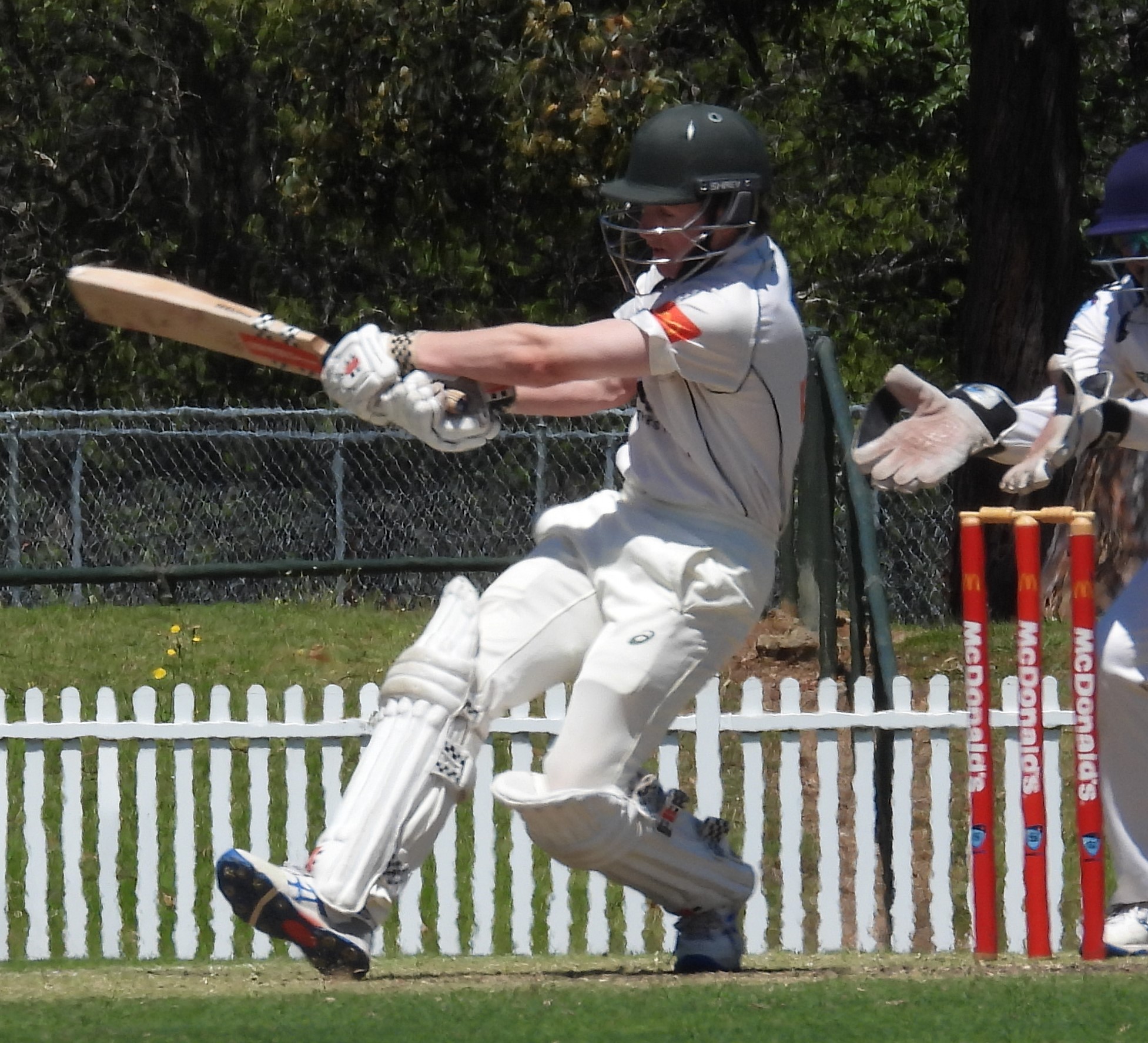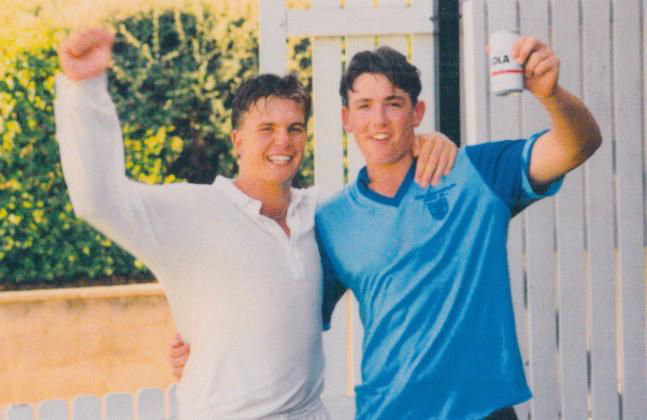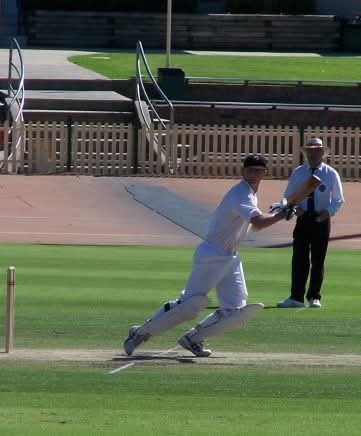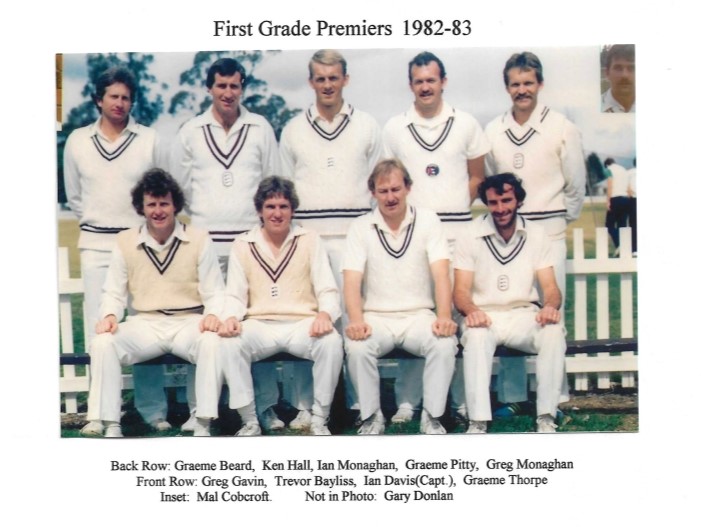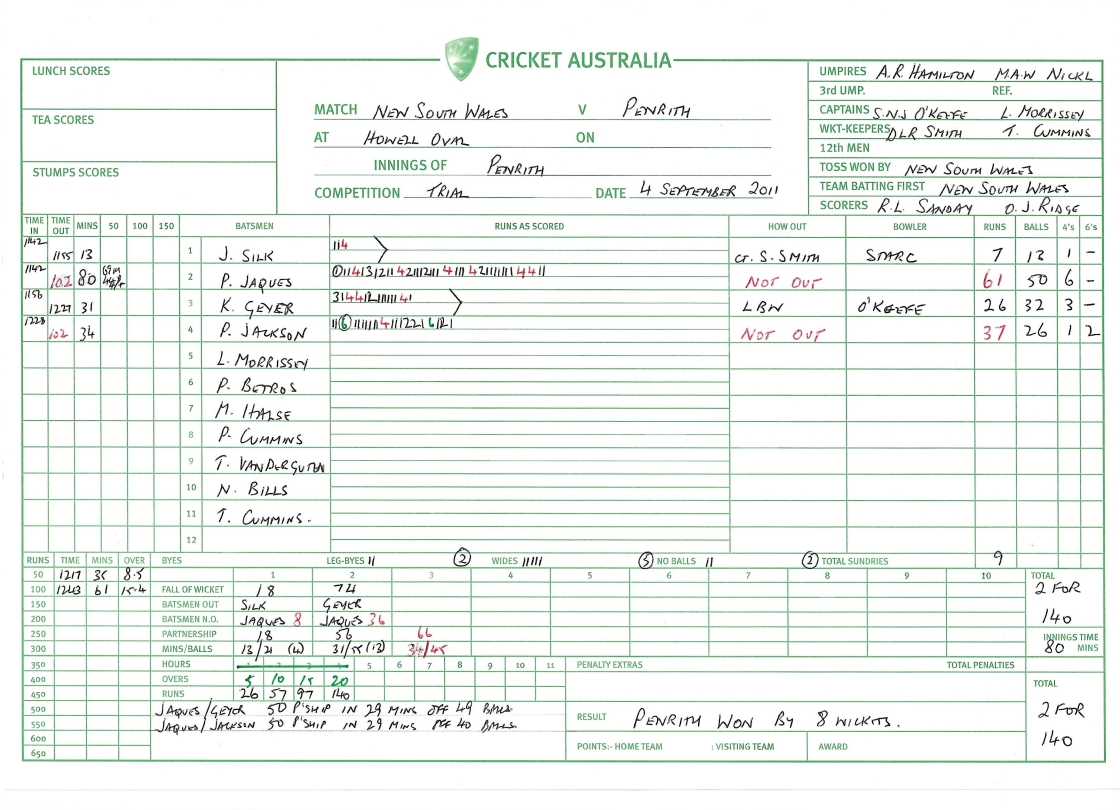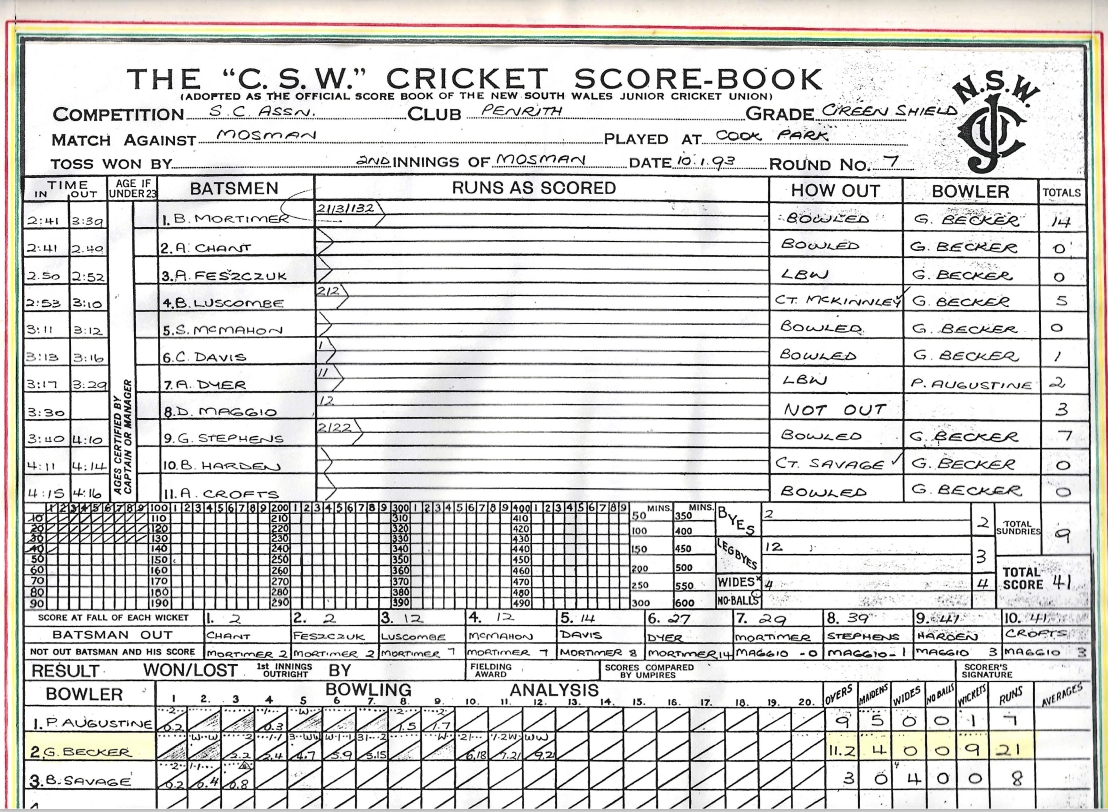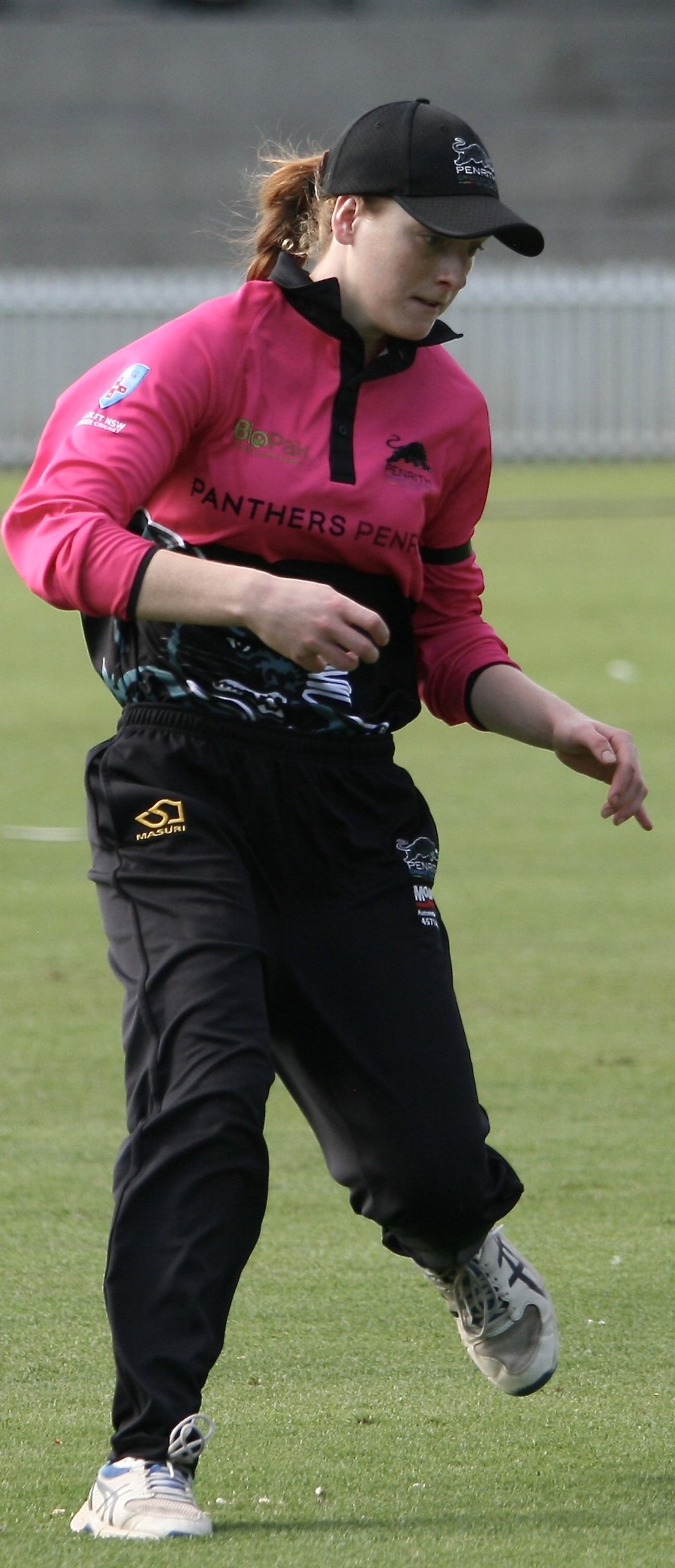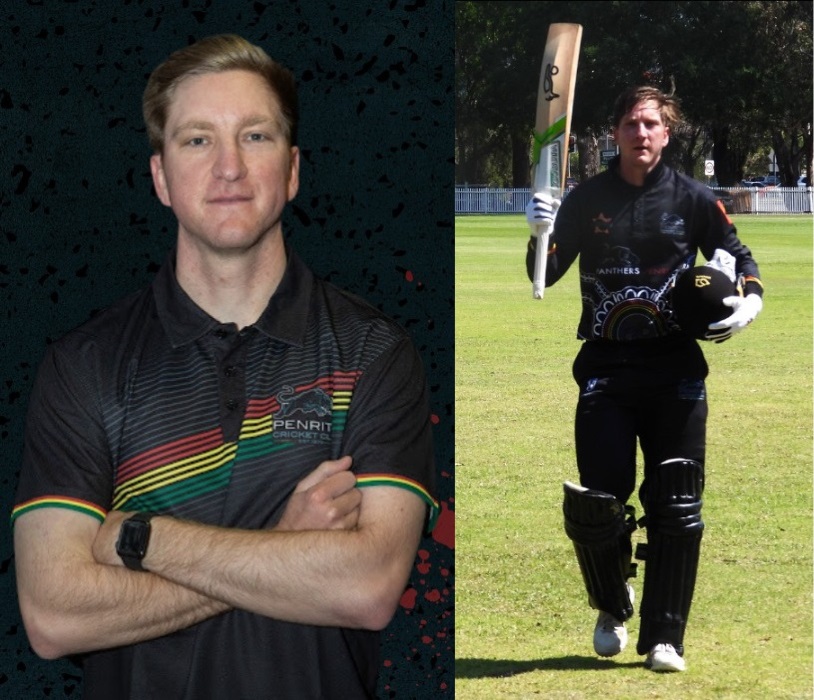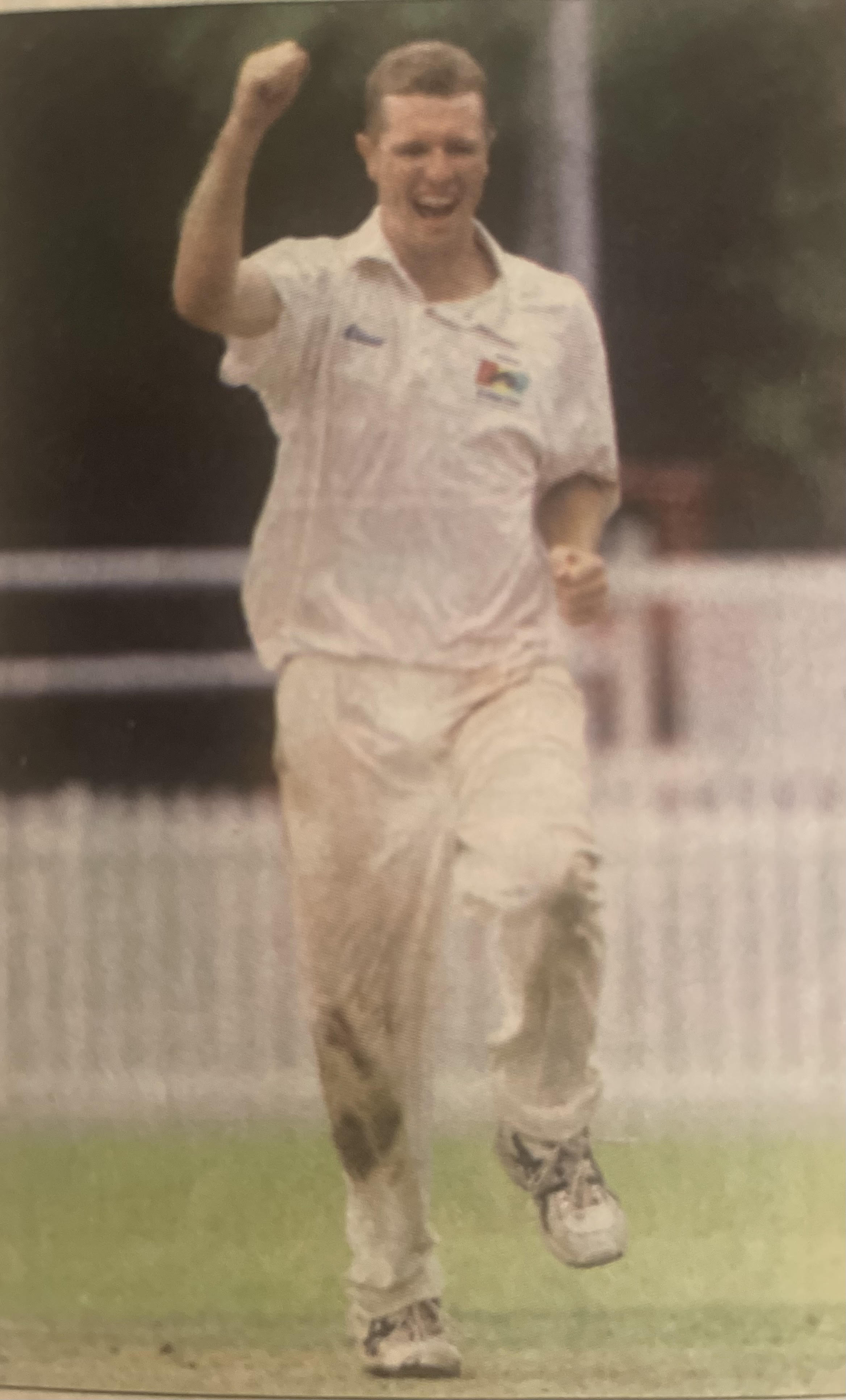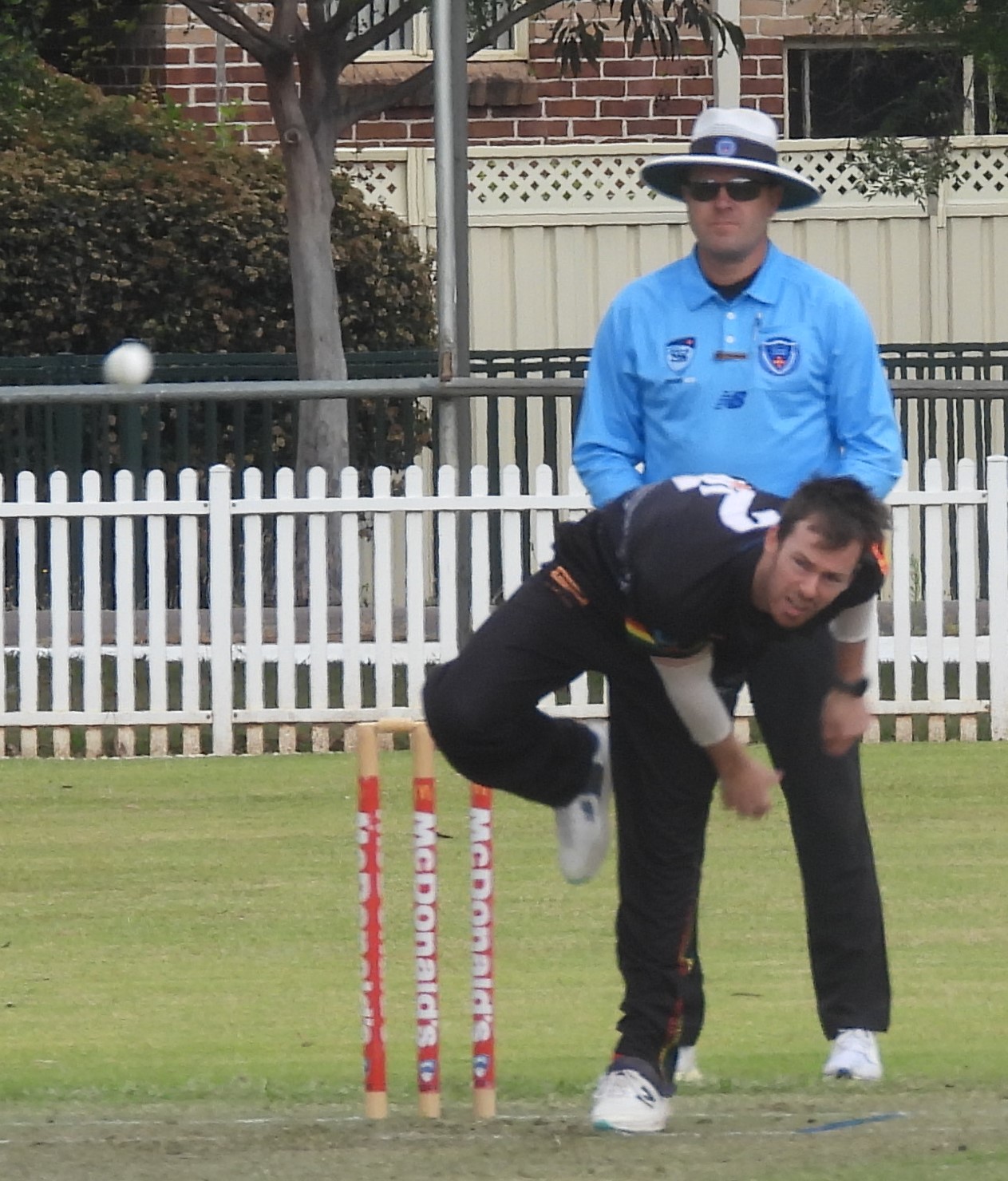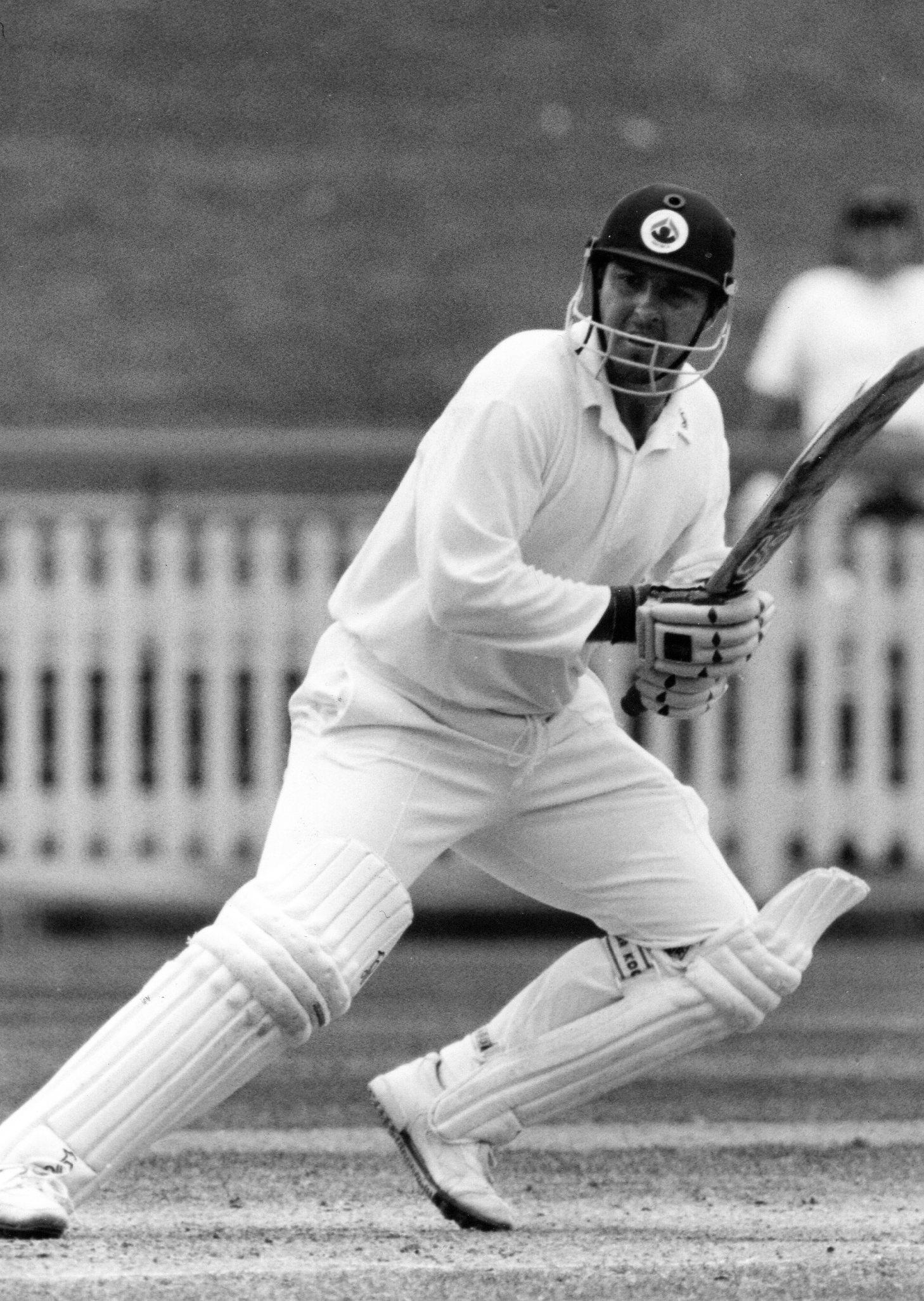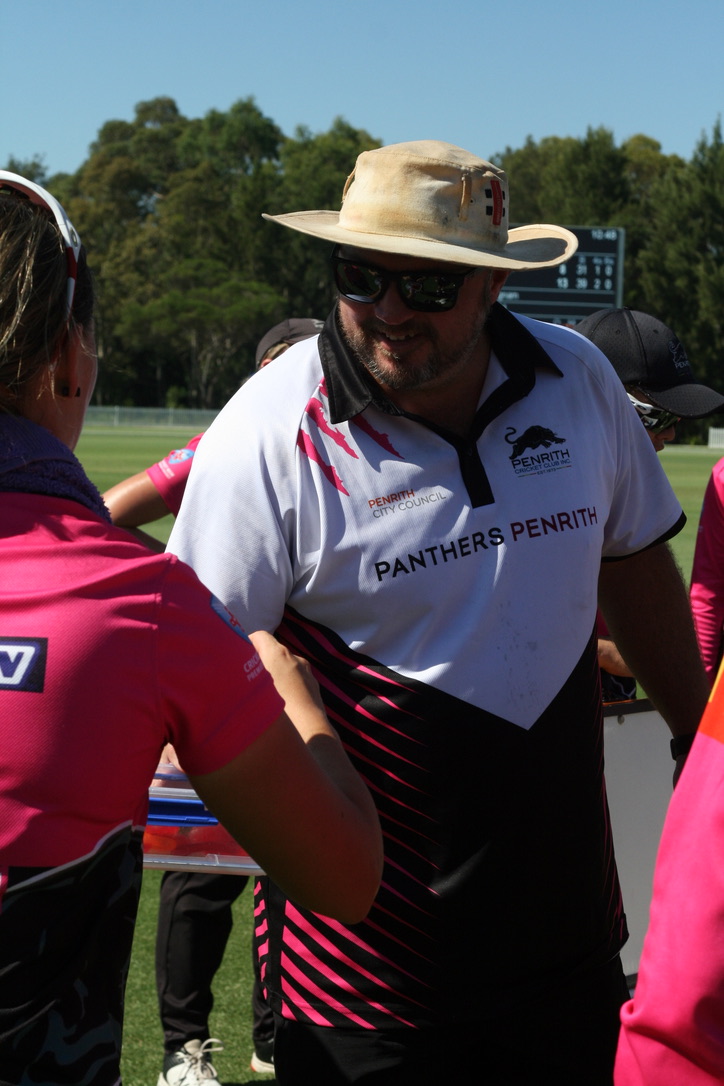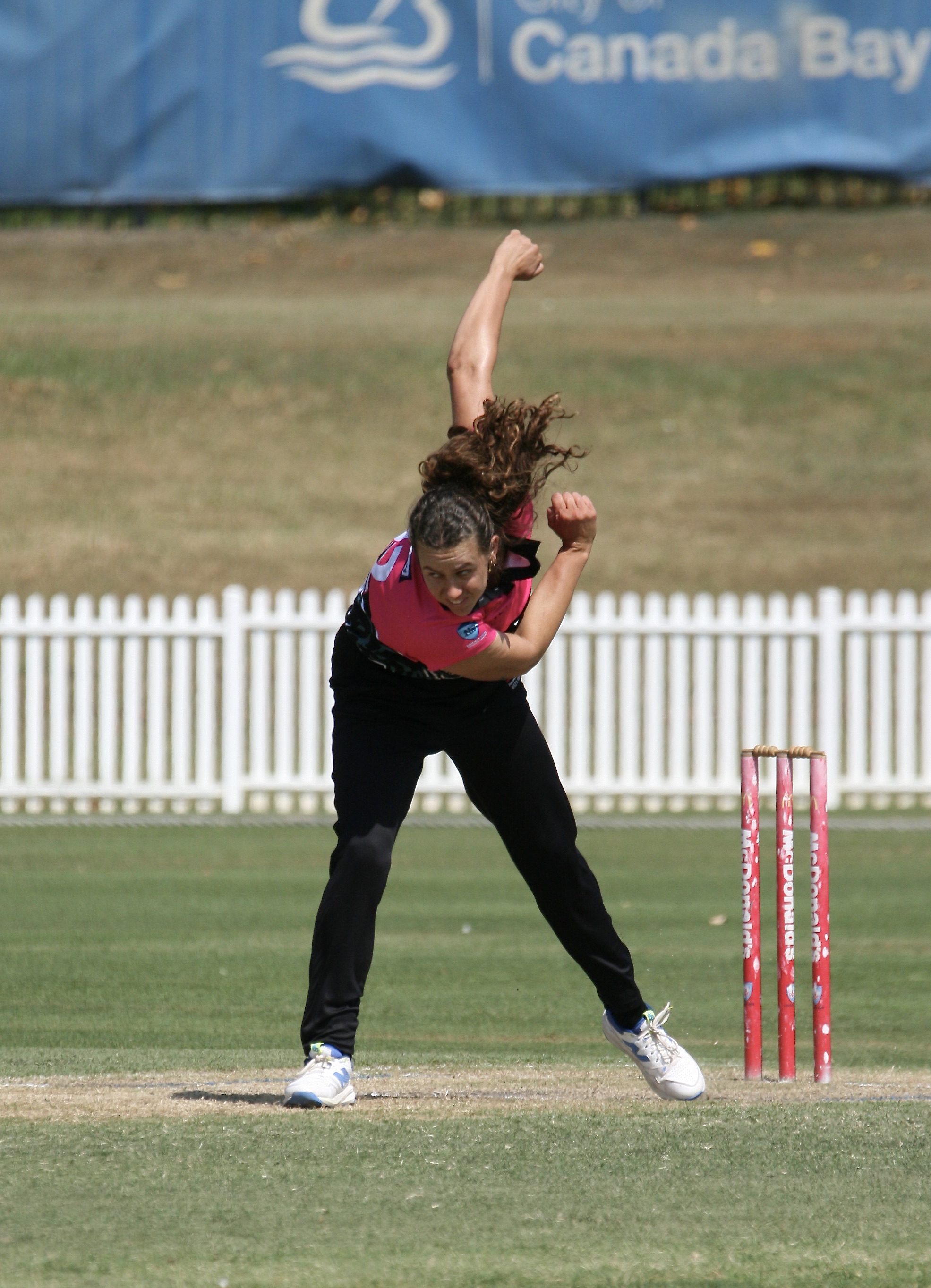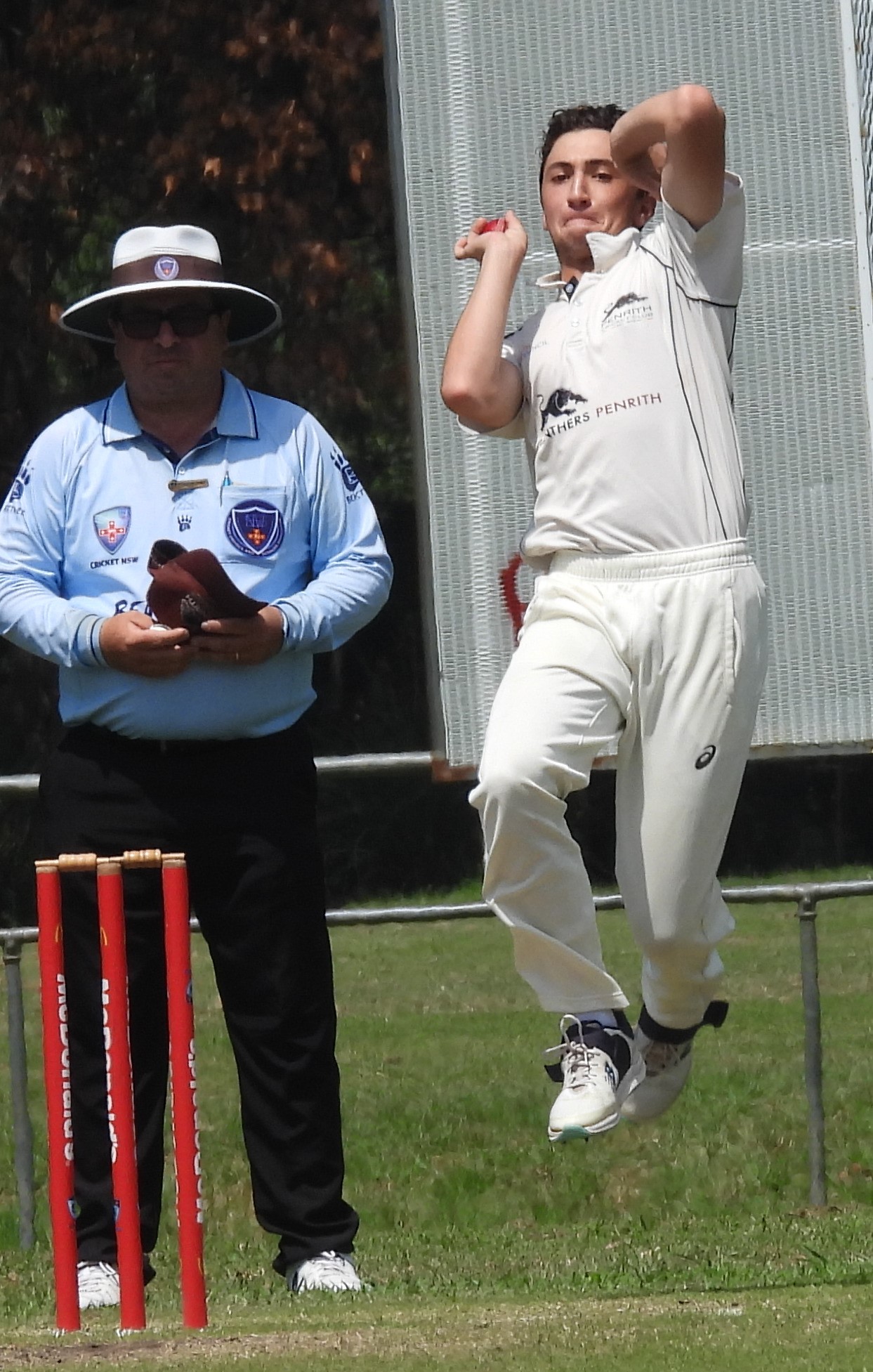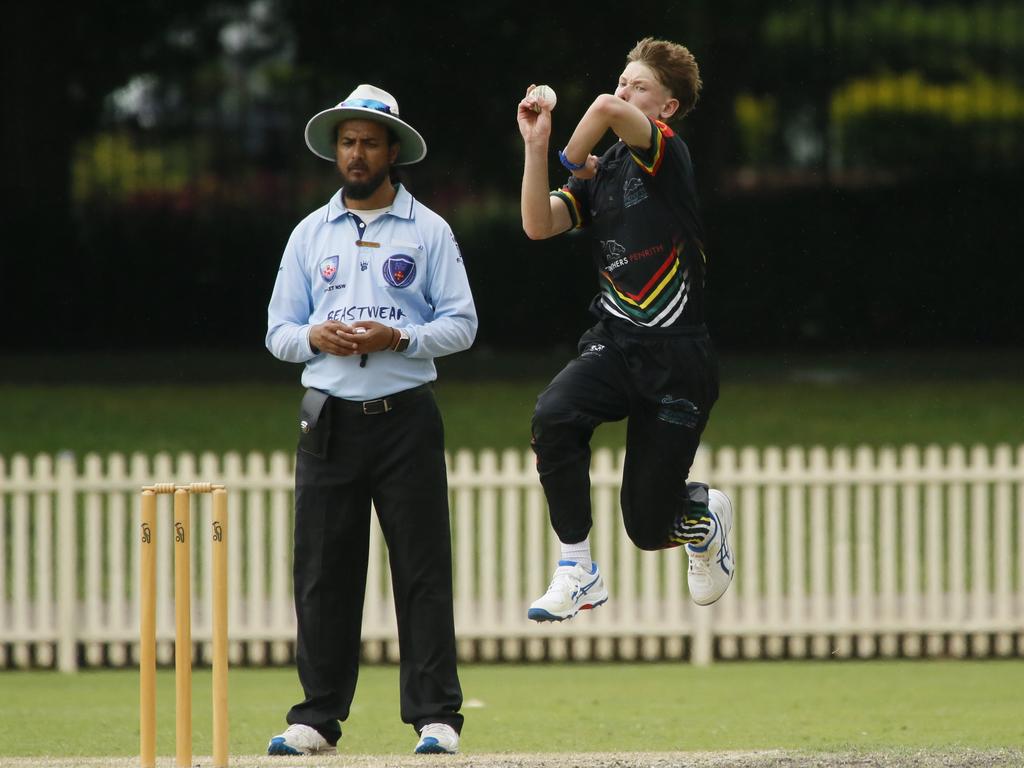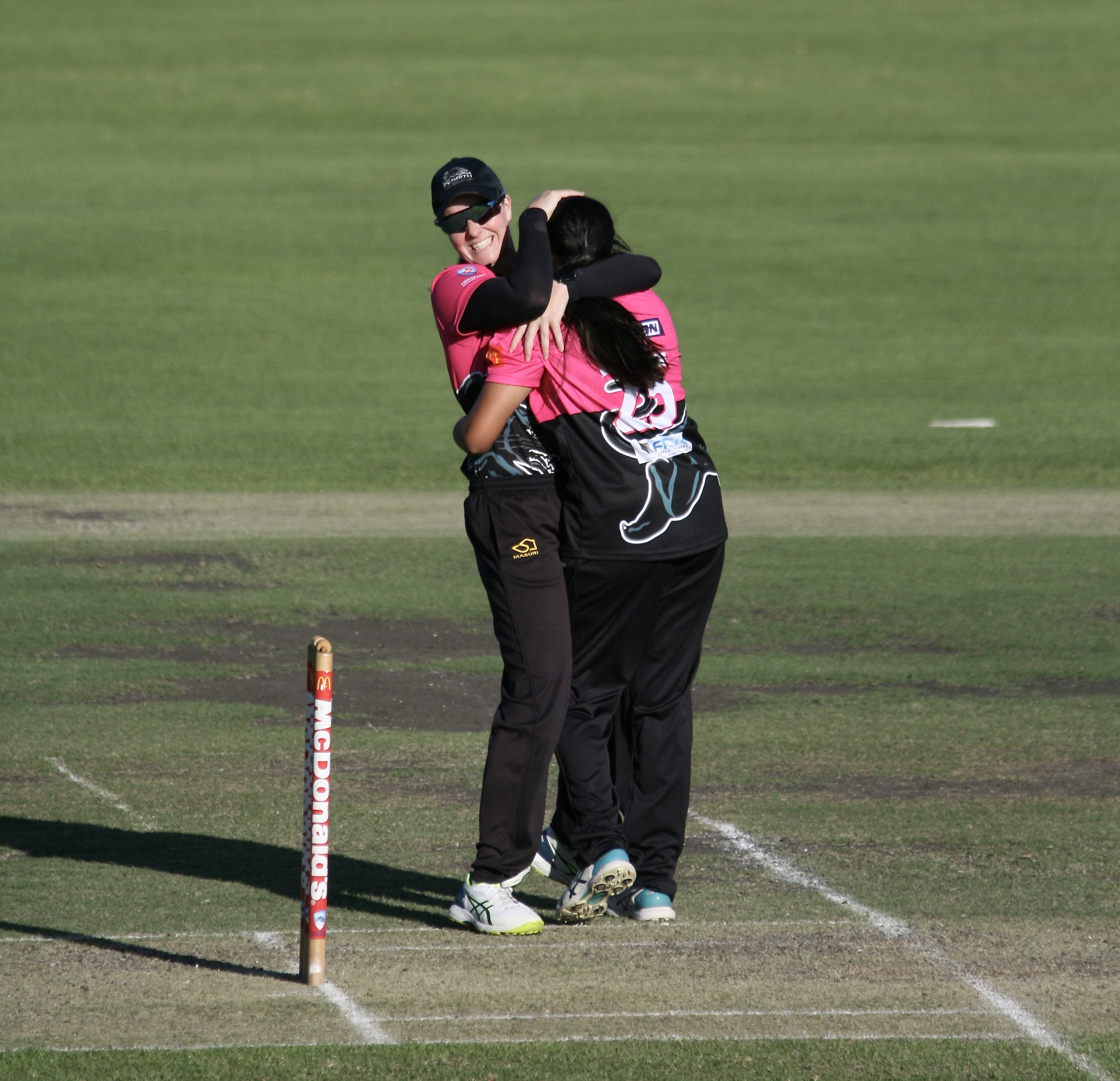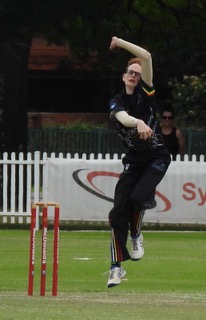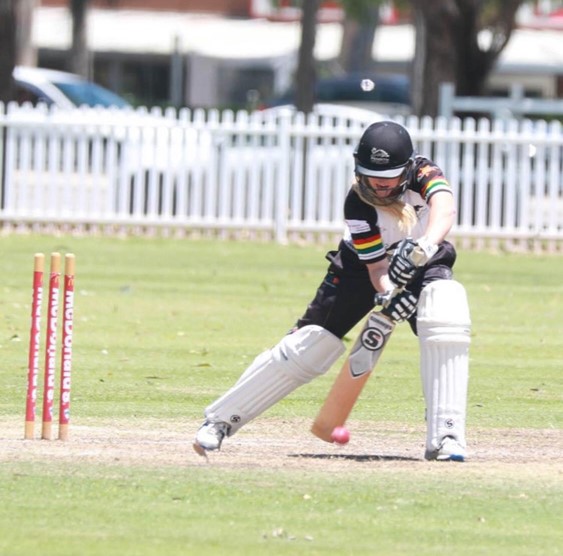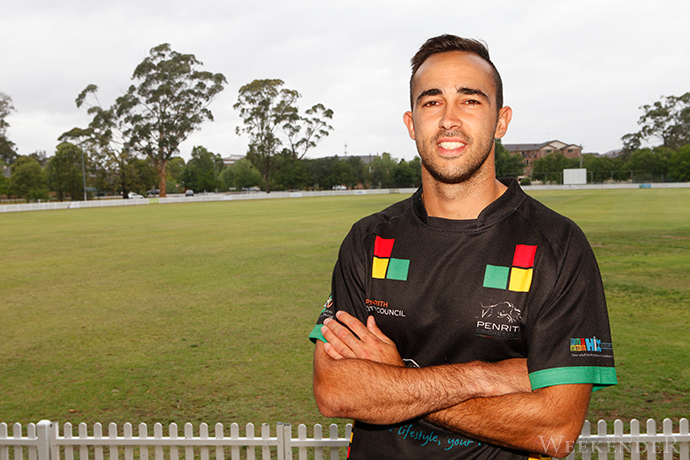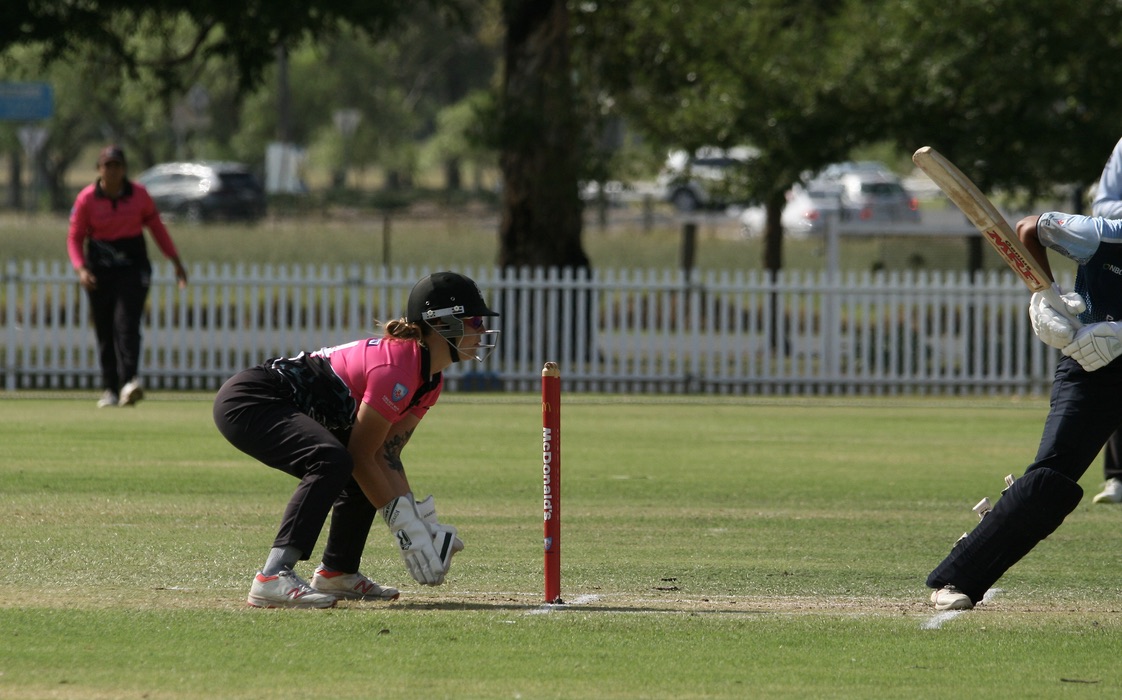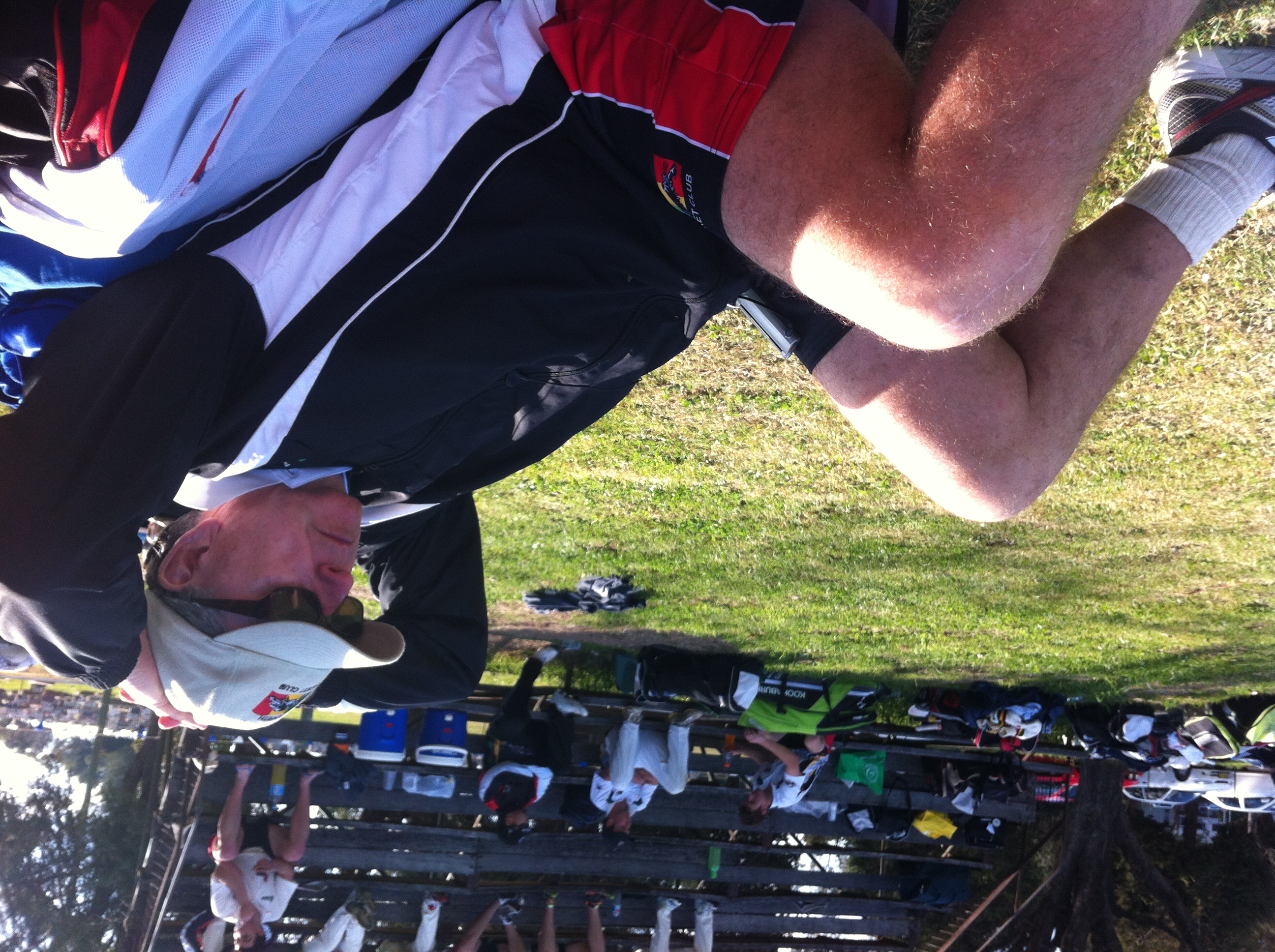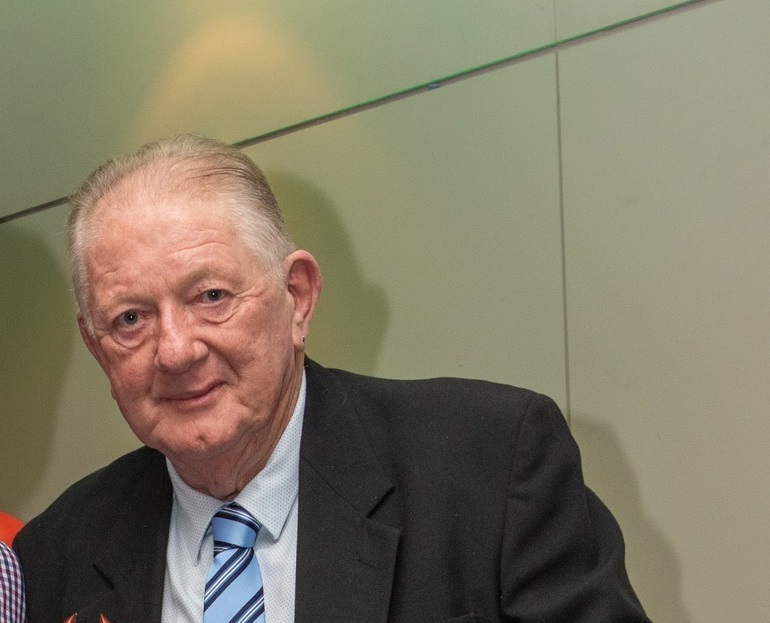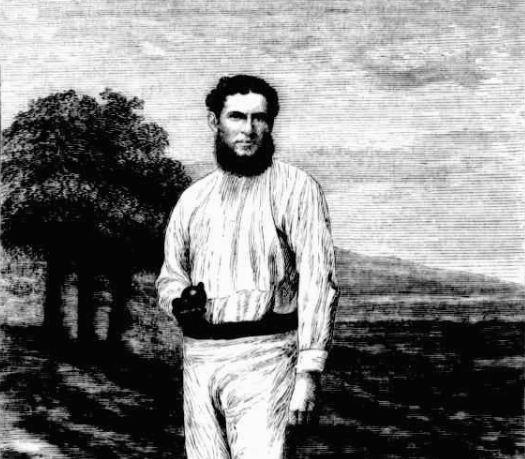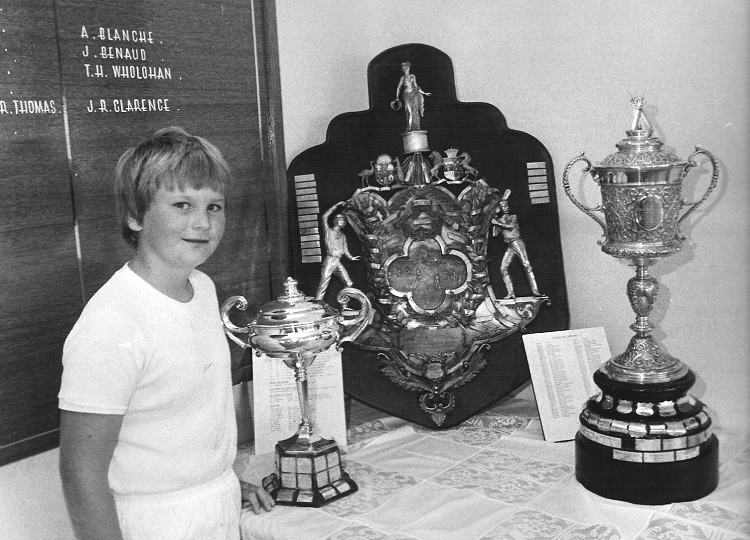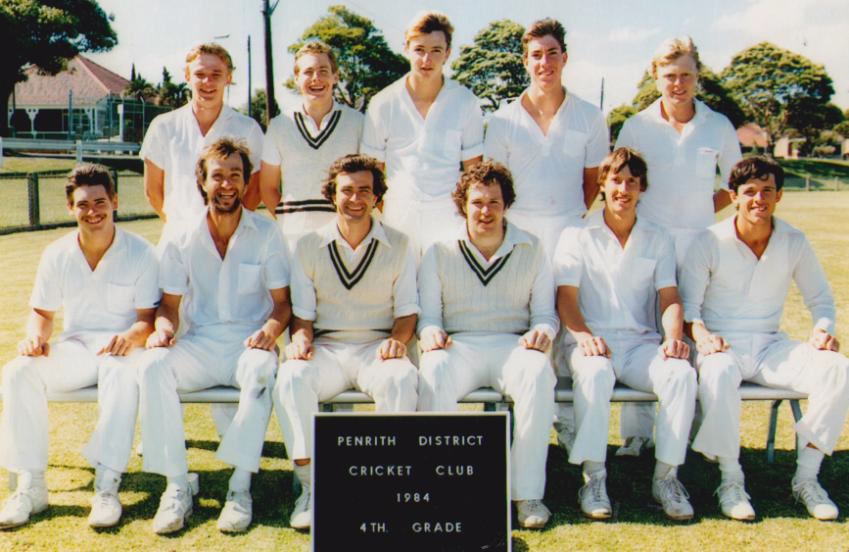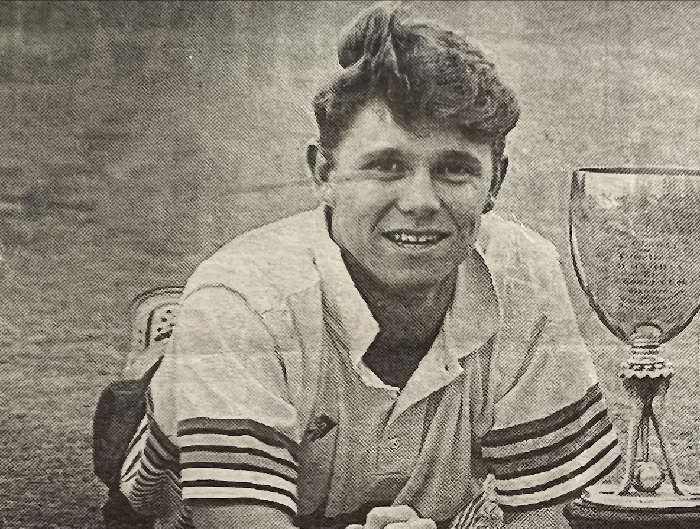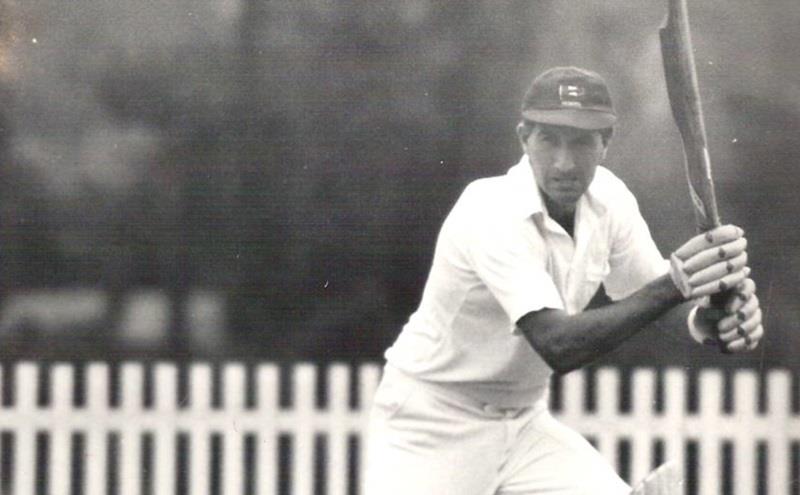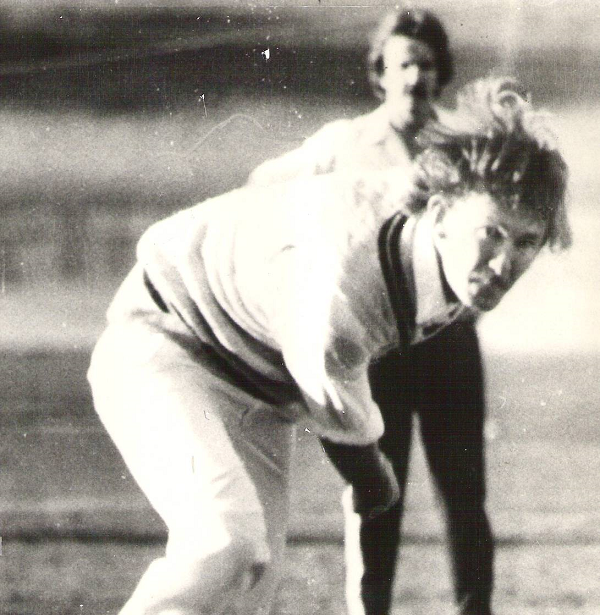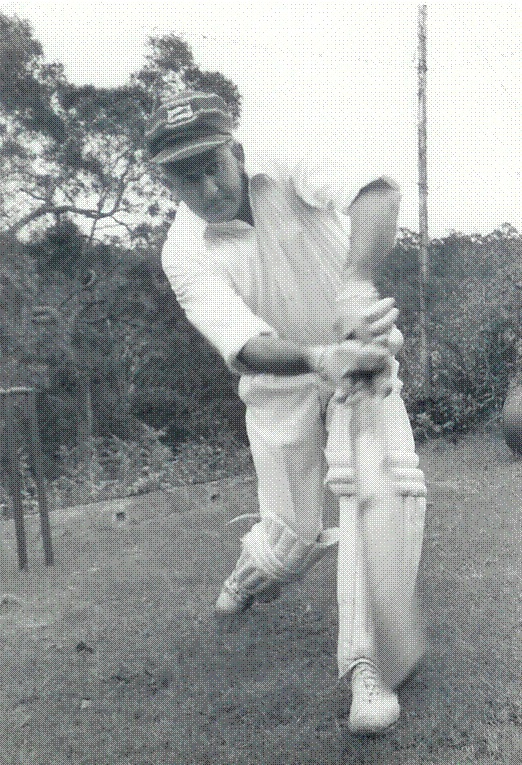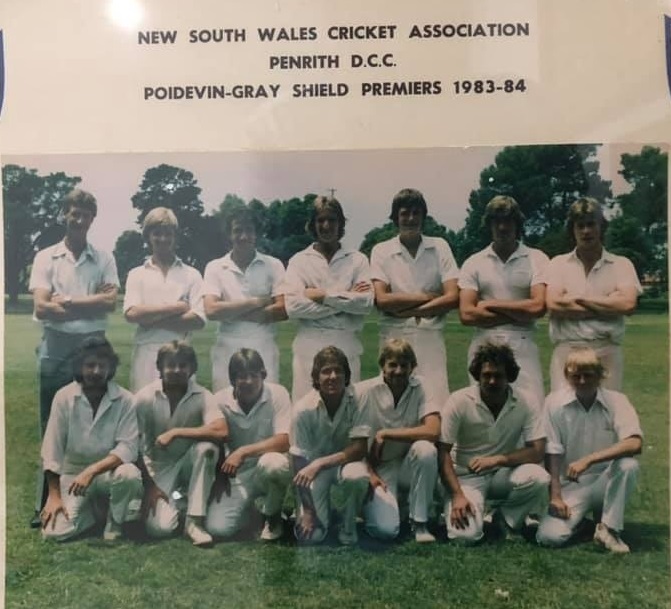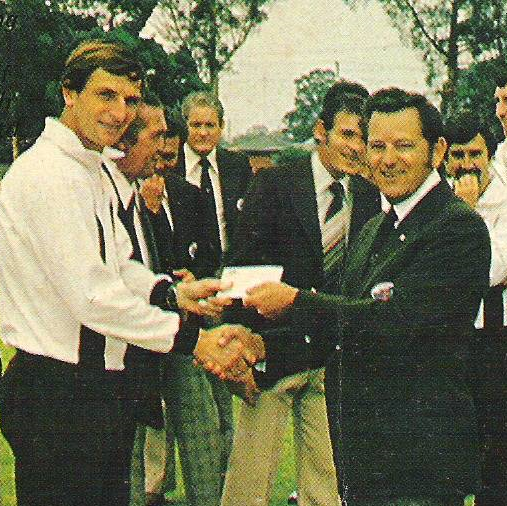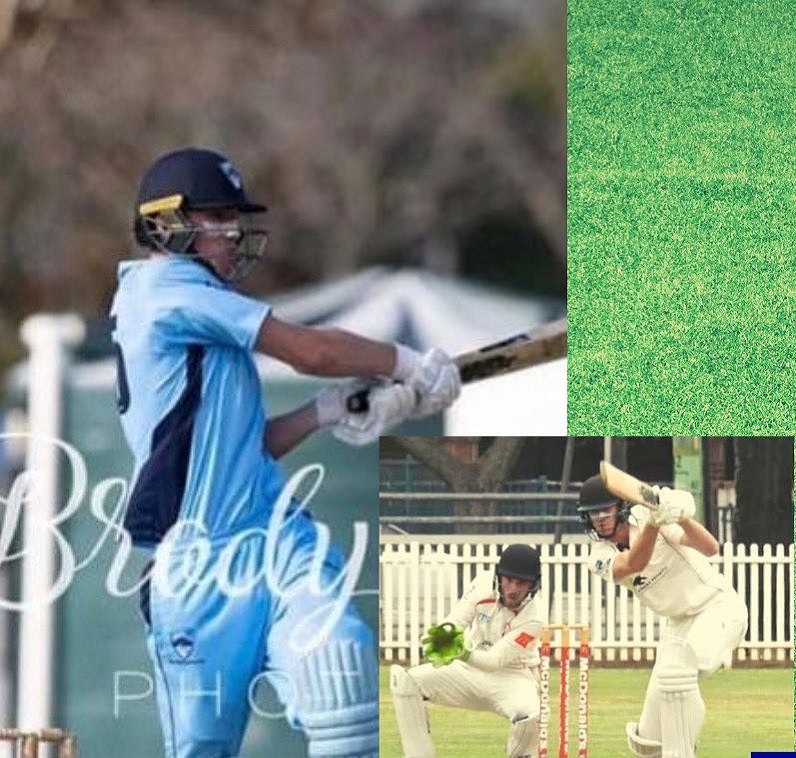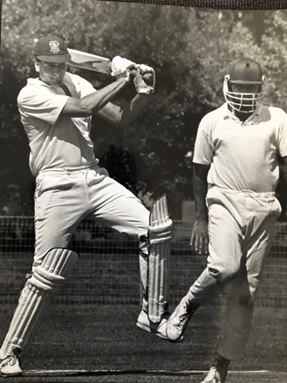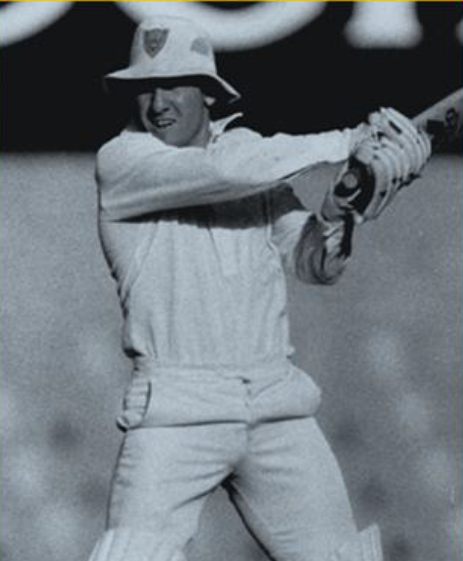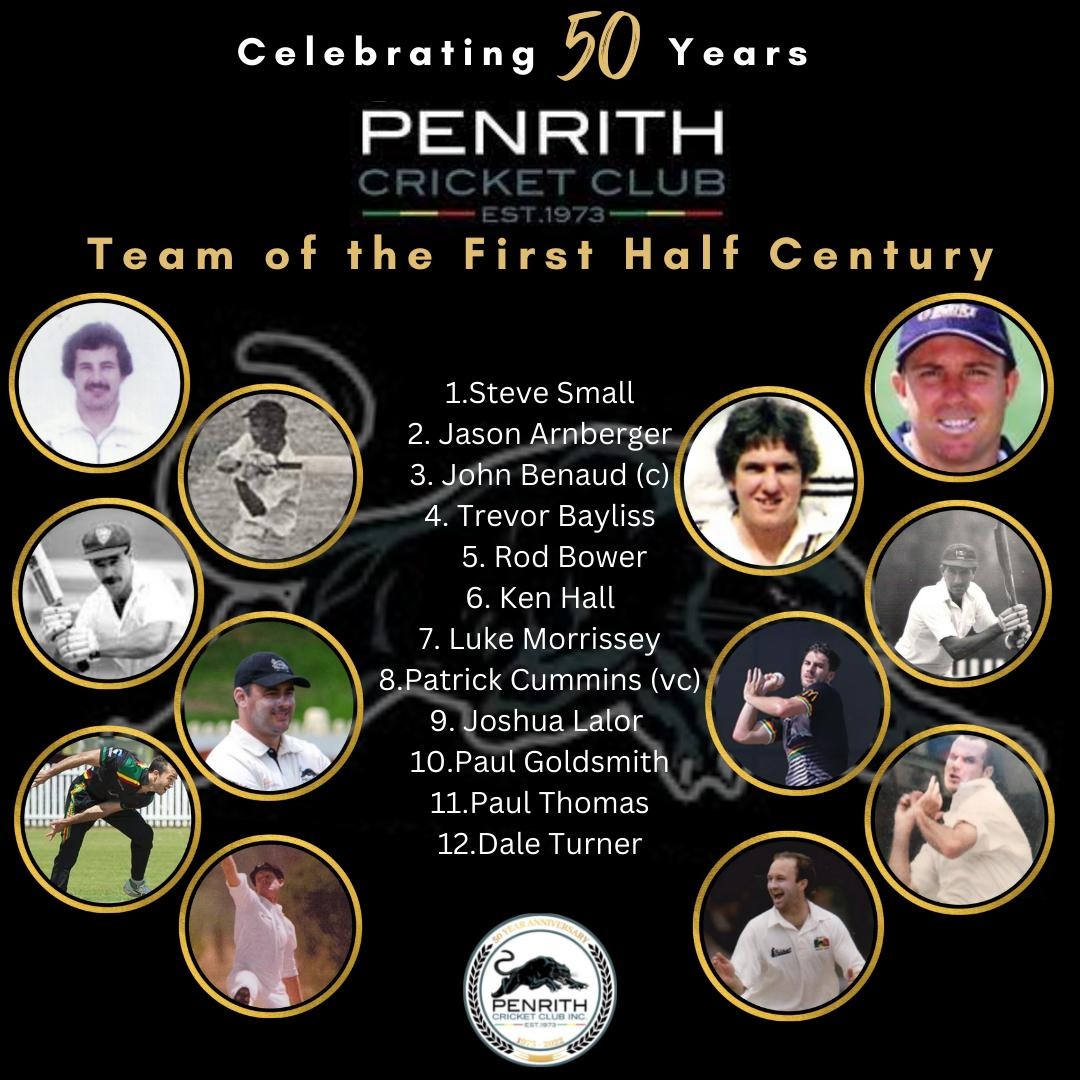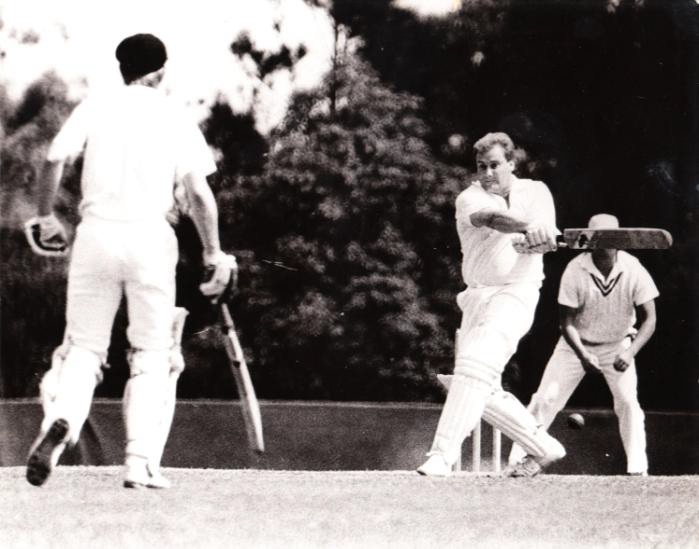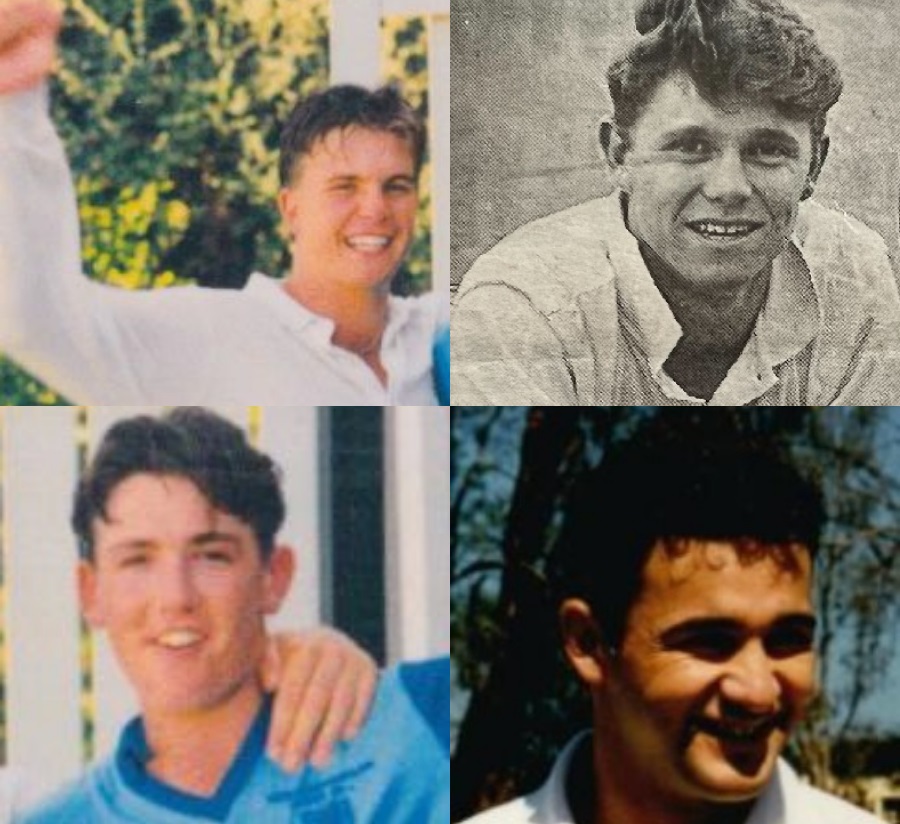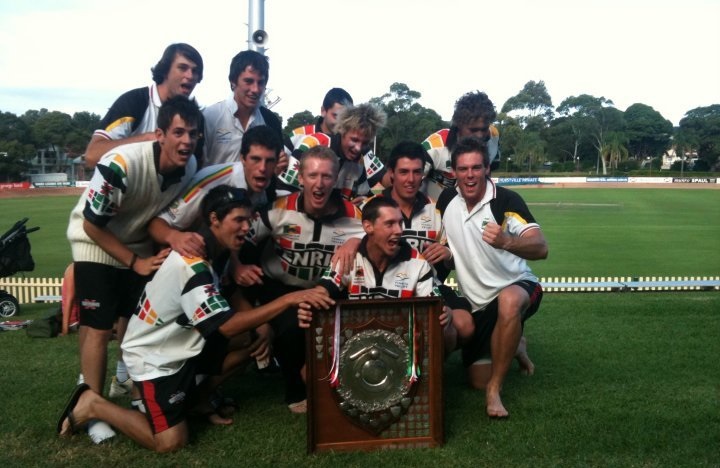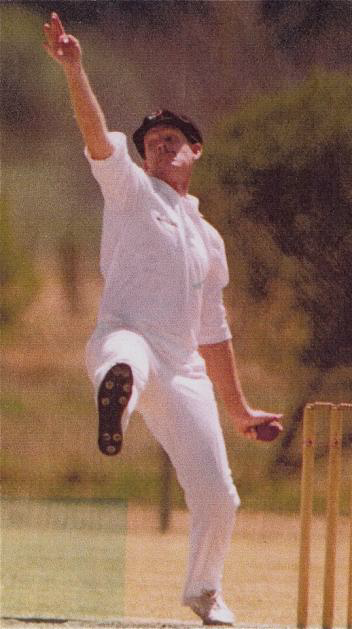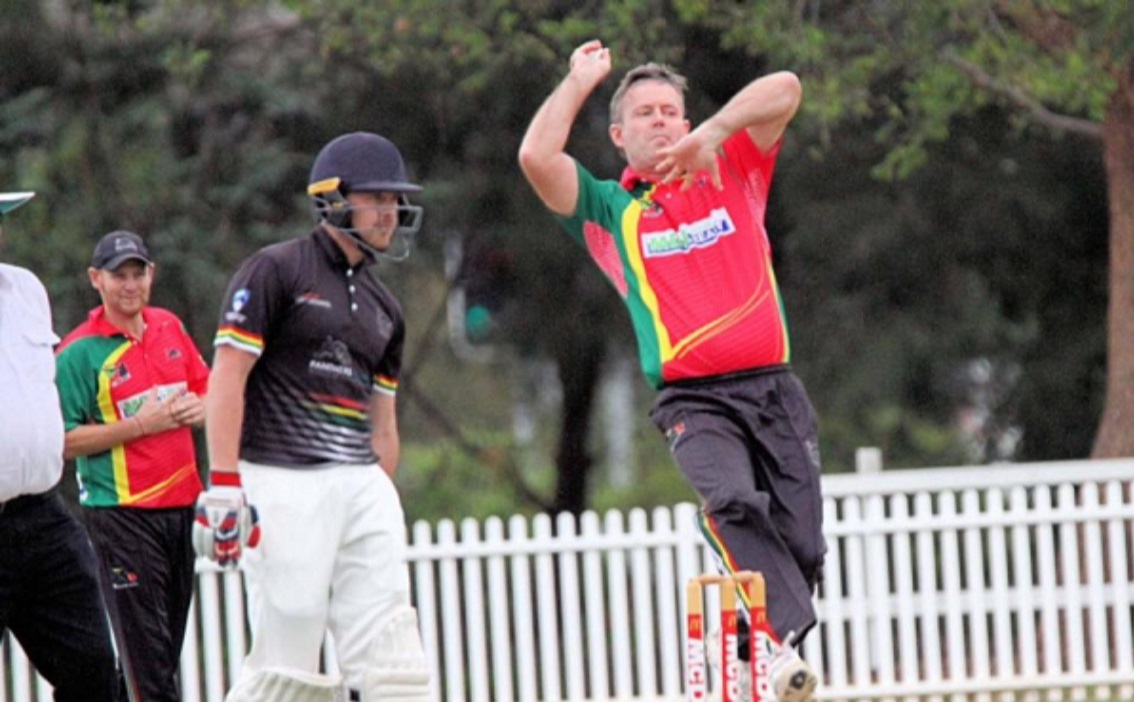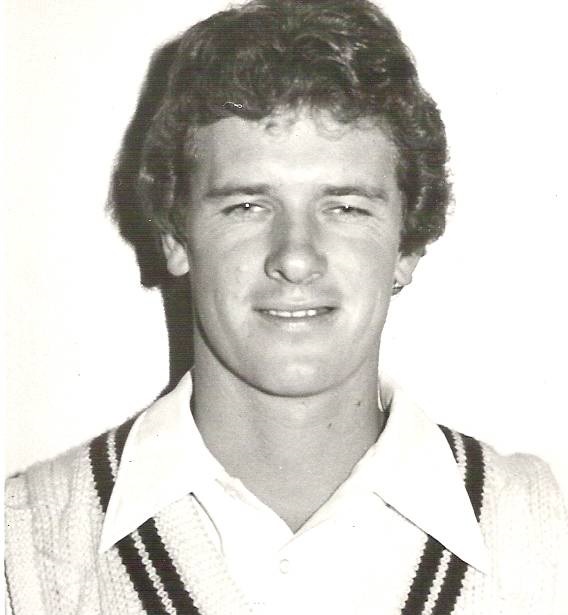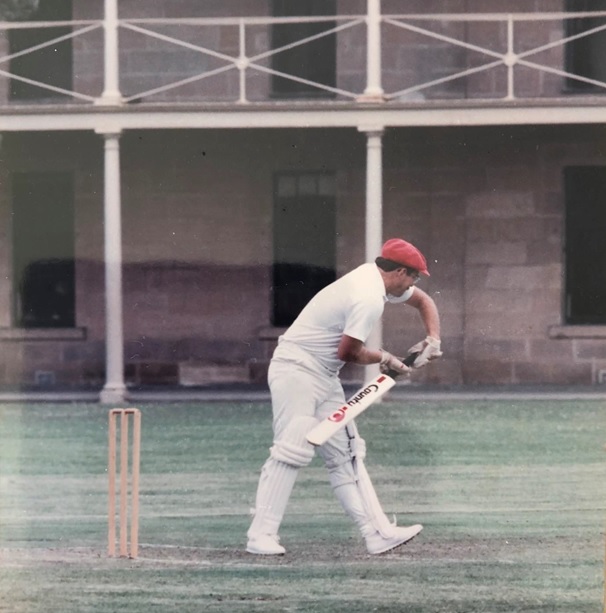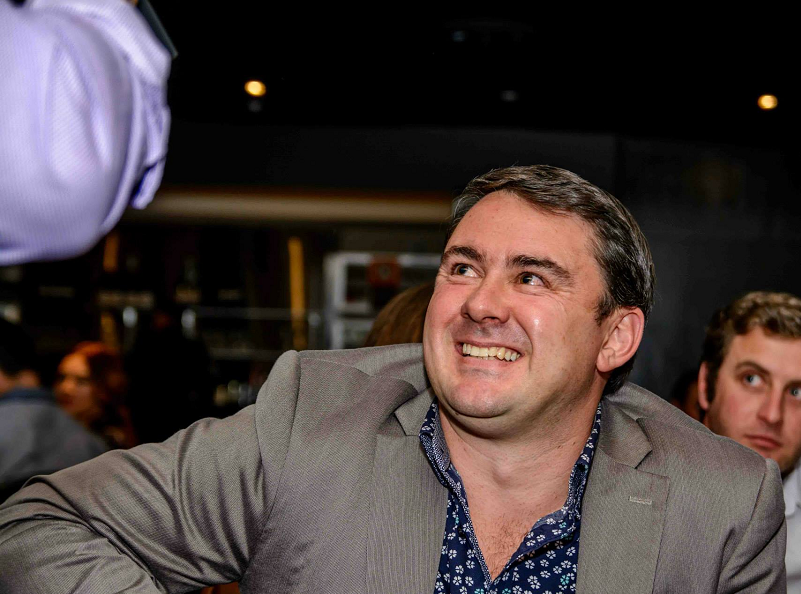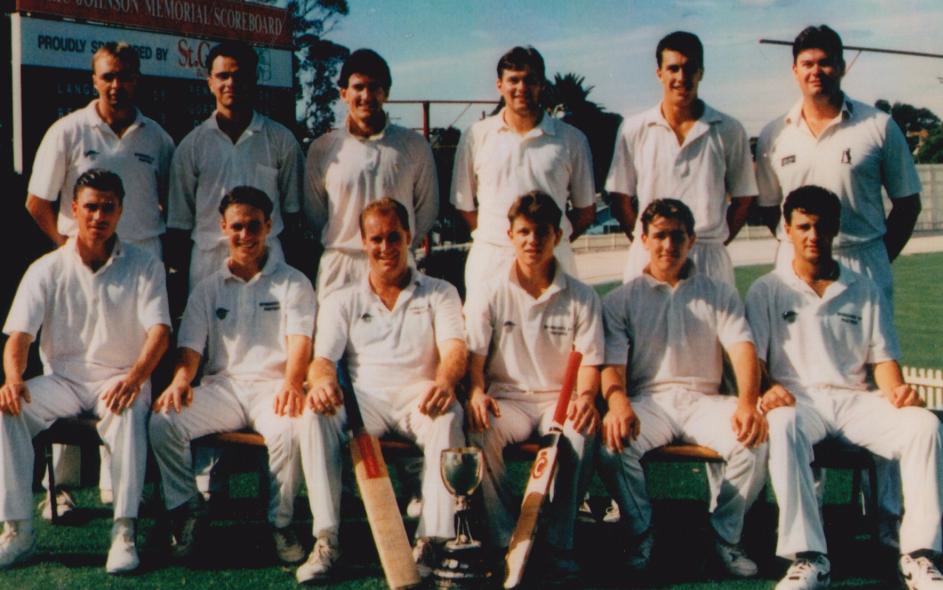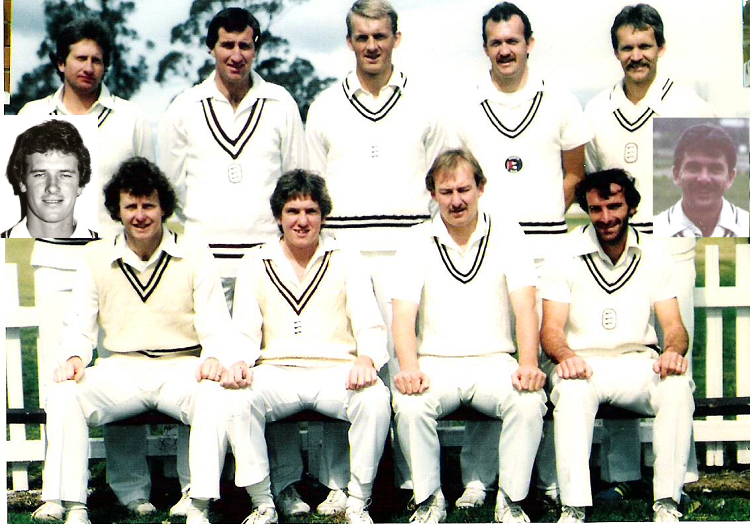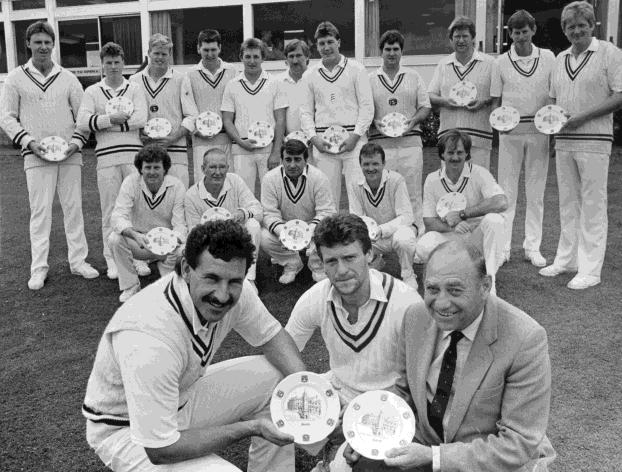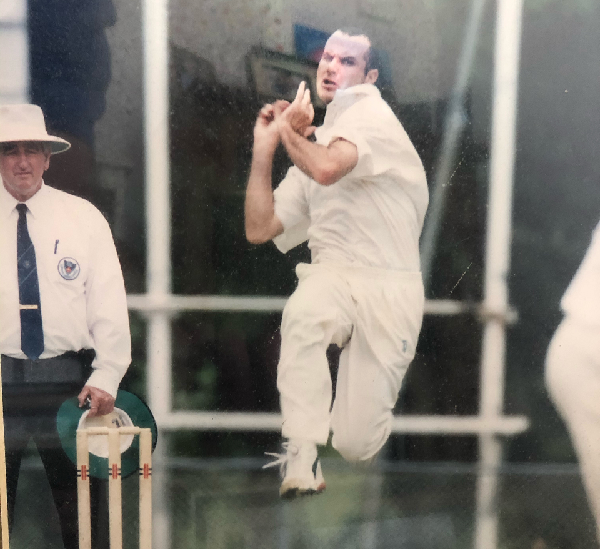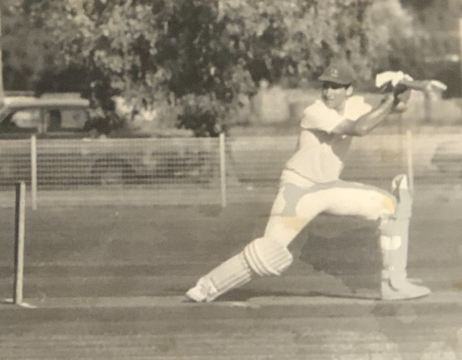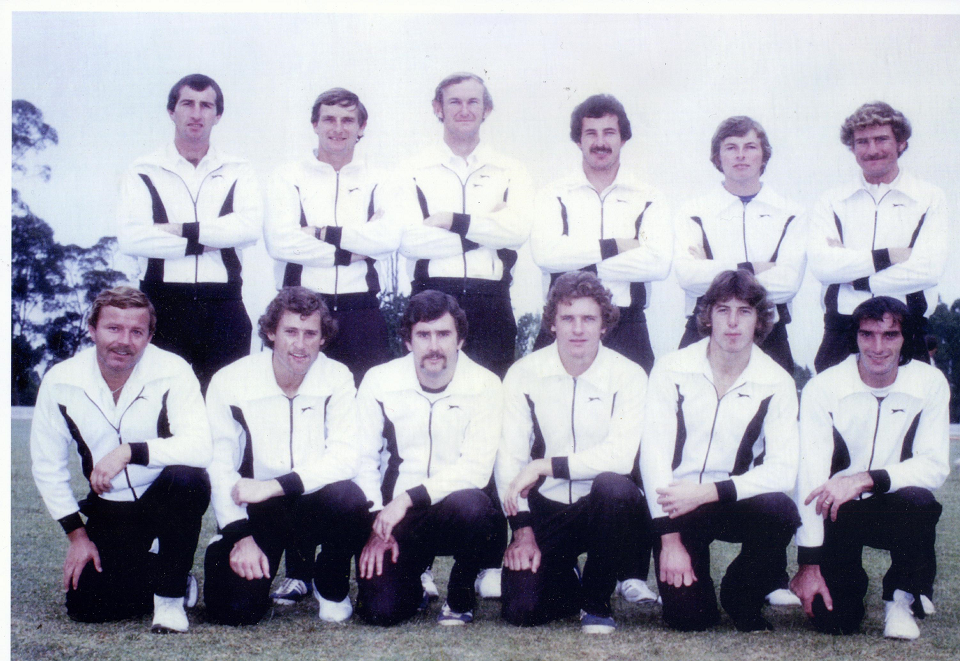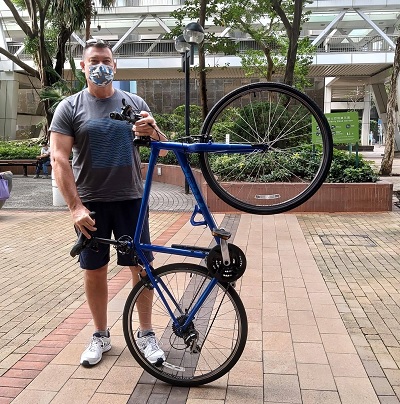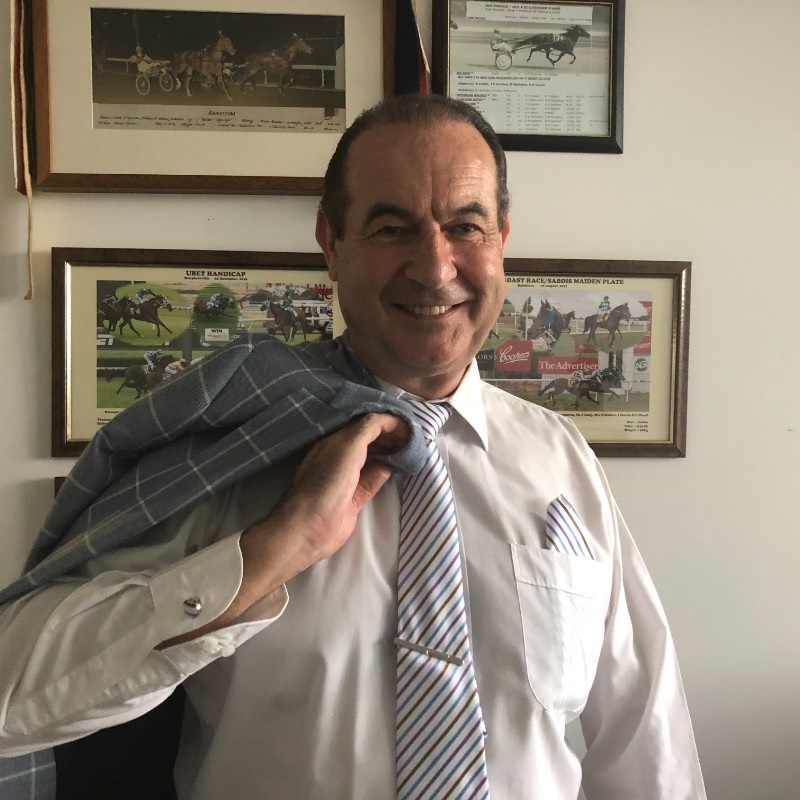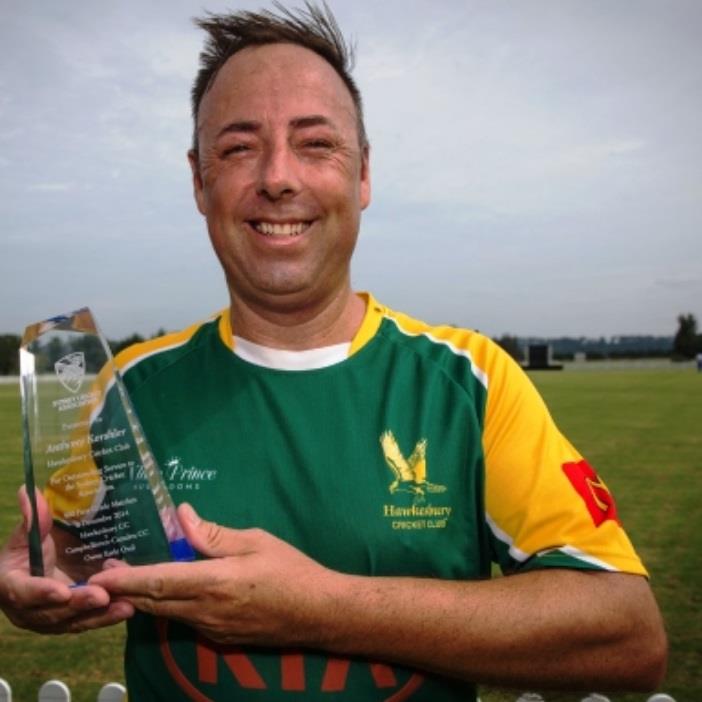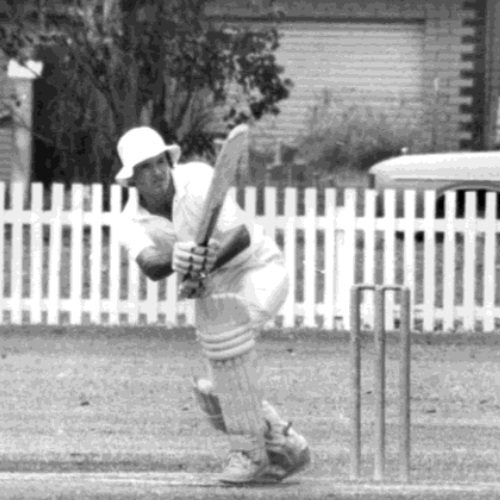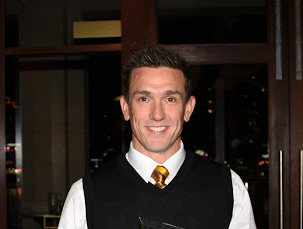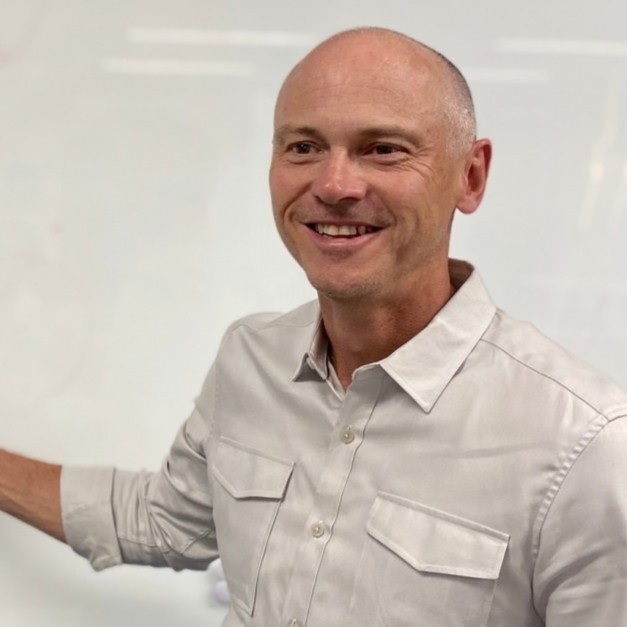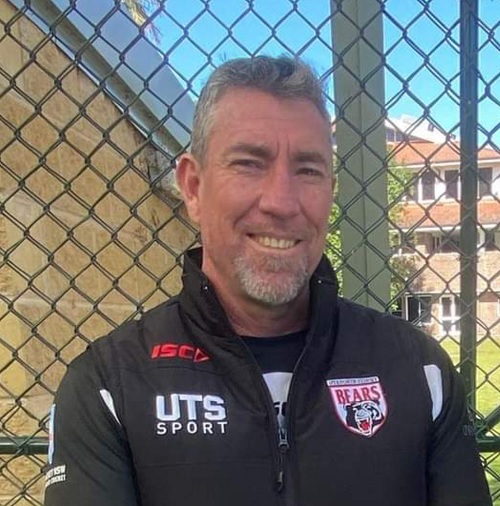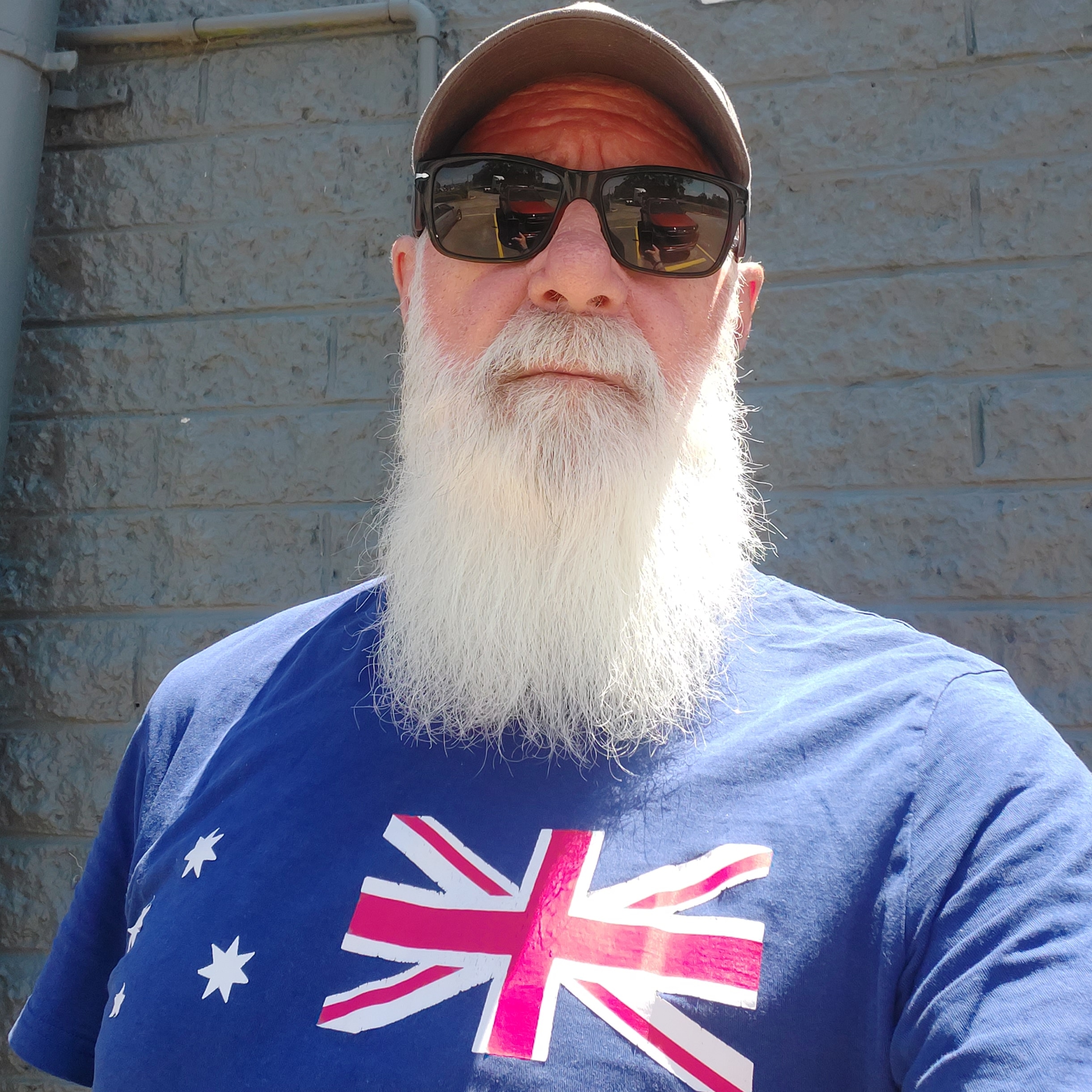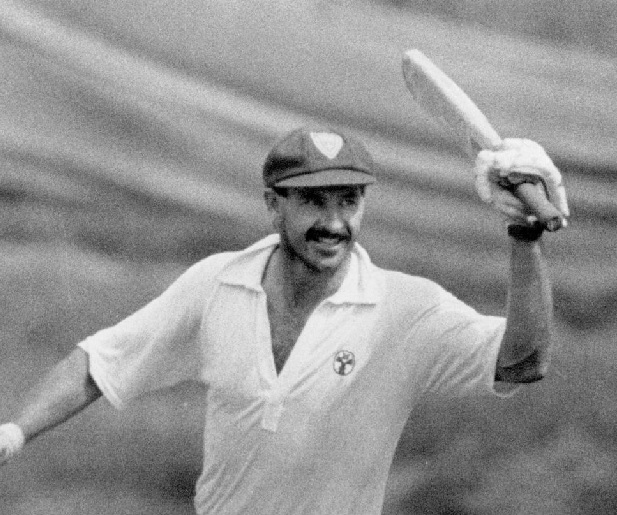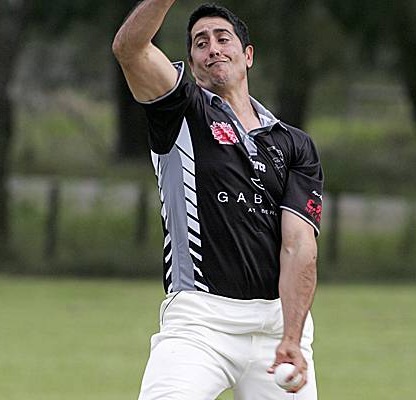About Me
Penrith Cricket Club
Sydney, Australia
Penrith Cricket Club (also known as the Panthers) represents the Penrith and Blue Mountains region in the NSW Premier Cricket Competition. Penrith Cricket Club was founded in 1973 under Nepean District Cricket Club. Penrith Cricket Club's home grounds include Howell Oval, Bill Ball Oval and Rance Oval.
Partner Sponsors
My Activity
blog post
Back Row: Grant Parmenter, Peter Sredojevic, Phil Chie, Brett Wheeldon, Jason Conn, Andrew BennettFront Row: Matt Langdon, Darren Reeves, Greg Douglas (Captain), Murray Rayner, Gary Sheen, P ...
question
Q: Zach Williams is a young wicket keeper batter at Penrith Cricket Club.
In his first season out of Green Shield Zach made his 3rd grade debut during the 2024-25 season.
Let’s find out more about Zach’s journey so far.
In his first season out of Green Shield Zach made his 3rd grade debut during the 2024-25 season.
Let’s find out more about Zach’s journey so far.
https://www.cricconnect.com/profile/330/penrith-cricket-club/blog/2946/pocket-profile-zach-williams-penrith-cricket-club
blog post
Zach Williams is a young wicket keeper batter at Penrith Cricket Club.In his first season out of Green Shield Zach made his 3rd grade debut during the 2024-25 season.Let’ ...
question
Q: Callan Kean is a left hand opening batter and Penrith Cricket Club’s first grade player number 240.
Callan made his first grade debut during the 2023-24 NSW Premier Cricket season.
Let's find out more about Callan’s journey in the game so far.
Callan made his first grade debut during the 2023-24 NSW Premier Cricket season.
Let's find out more about Callan’s journey in the game so far.
https://www.cricconnect.com/profile/330/penrith-cricket-club/blog/2939/callan-kean-first-grade-cap-number-240-penrith-cricket-club
blog post
Callan Kean is a left hand opening batter and Penrith Cricket Club’s first grade player number 240.Callan made his first grade debut during the 2023-24 NSW Premier Cricket season.Le ...
question
Q: Penrith Press Article 12/10/2001 - Penrith Cricket Club
https://www.cricconnect.com/profile/330/penrith-cricket-club/blog/2922/penrith-press-article-12102001-penrith-cricket-club
blog post
Produly brought to you by our good friends at Kingsgrove Sports ...
question
Q: Will Hicks is a promising young opening bowler who made his second grade debut for the club in 2024-25.
What year were you born?
I was born in the year 2007
Position: (e.g., batsman, bowler, all-rounder, keeper)
I am a bowler and a genuine number 11 batsman
I bowl right arm fast / medium
What year were you born?
I was born in the year 2007
Position: (e.g., batsman, bowler, all-rounder, keeper)
I am a bowler and a genuine number 11 batsman
https://www.cricconnect.com/profile/330/penrith-cricket-club/blog/2914/pocket-profile-will-hicks-penrith-cricket-club
I bowl right arm fast / medium
blog post
Will Hicks is a promising young opening bowler who made his second grade debut for the club in 2024-25.Let's find out more about Will's journey in the game so farWh ...
question
Q: On January 25th 2002, Dale Turner debuted for NSW against Victoria in the Pura Cup (previously playing for QLD). In the Victorian side, it also included Penrith First Grade Cap #102 Jason Arnberger.
As pictured above, Turner is pictured wearing his Baggy Blue with Penrith's all-time leading wicket taker and fellow spinner, Paul Thomas. Turner would record scores of 5 & 2, while returning figures of 0/66 & 0/25. Although in the 2001/02 First Grade season, he would score 331 runs at 41.38 and take 33 wickets at 15.03
As pictured above, Turner is pictured wearing his Baggy Blue with Penrith's all-time leading wicket taker and fellow spinner, Paul Thomas. Turner would record scores of 5 & 2, while returning figures of 0/66 & 0/25. Although in the 2001/02 First Grade season, he would score 331 runs at 41.38 and take 33 wickets at 15.03
https://www.cricconnect.com/profile/330/penrith-cricket-club/blog/2907/dale-turner-nsw-debut-penrith-cricket-club
blog post
On January 25th 2002, Dale Turner debuted for NSW against Victoria in the Pura Cup (previously playing for QLD). In the Victorian side, it also included Penrith First Grade Cap #102 Jason Arnberger ...
question
Q: On the 15 February 2025 Liam Devaney scored 105 in Penrith 3rd grade win against Sydney at Cook Park. It was his first century for the club.
Liam’s had a very productive season with the bat in 2024-25 scoring 459 runs at an average of 51.
Let’s find out more about Liam’s journey in the game so far.
Liam’s had a very productive season with the bat in 2024-25 scoring 459 runs at an average of 51.
Let’s find out more about Liam’s journey in the game so far.
https://www.cricconnect.com/profile/330/penrith-cricket-club/blog/2896/player-profile-liam-devaney-penrith-cricket-club
blog post
On the 15 February 2025 Liam Devaney scored 105 in Penrith 3rd grade win against Sydney at Cook Park. It was his first century for the club.Liam’s had a very productive season w ...
question
Q: In his first year at Penrith Cricket Club Ekam Bhambra played in the under 16 Green Shield team and took 11 wickets at an average of 16.18. His best figures was 4 for 35 against Eastern Suburbs.
Let's find out a little more about Ekam and his journey in the game so far.
Let's find out a little more about Ekam and his journey in the game so far.
https://www.cricconnect.com/profile/330/penrith-cricket-club/blog/2885/pocket-profile-ekam-bhambra-penrith-cricket-club
blog post
In his first year at Penrith Cricket Club Ekam Bhambra played in the under 16 Green Shield team and took 11 wickets at an average of 16.18. His best figures was 4 for 35 against Eastern Suburbs. ...
question
Q: Riley Killeen was Penrith Cricket Club Green Shield wicket keeper and opening batter in 2024-25. Riley is a talented wicket keeper batter who has gained invaluable experience this season playing third and fourth grade in NSW Premier Cricket.
Lets find out a little more about Riley and his journey so far.
Lets find out a little more about Riley and his journey so far.
https://www.cricconnect.com/profile/330/penrith-cricket-club/blog/2852/pocket-profile-riley-killeen-penrith-cricket-club
blog post
Riley Killeen was Penrith Cricket Club Green Shield wicket keeper and opening batter in 2024-25. Riley is a talented wicket keeper batter who has gained invaluable experience this season playing th ...
question
Q: A.W.Green Shield Winners 1996/97 - Penrith Cricket Club
Standing from left to right:
M.Kerkham (Secretary), I.Scrivener (Scorer), L.Zamitt, K.Tollett, G.Bradley, M.Graham, M.Thompson, S.Williams, E.Stanford, D.Whiley, R.Hudswell (President)
Seated from left to right:
D.Thompson, M.Myerscough, R.Halse (Coach), M.Halse (Captain), R.Evans (Assistant Coach), C.Marazoitis, L.Morrissey
Standing from left to right:
M.Kerkham (Secretary), I.Scrivener (Scorer), L.Zamitt, K.Tollett, G.Bradley, M.Graham, M.Thompson, S.Williams, E.Stanford, D.Whiley, R.Hudswell (President)
Seated from left to right:
D.Thompson, M.Myerscough, R.Halse (Coach), M.Halse (Captain), R.Evans (Assistant Coach), C.Marazoitis, L.Morrissey
blog post
Standing from left to right:M.Kerkham (Secretary), I.Scrivener (Scorer), L.Zamitt, K.Tollett, G.Bradley, M.Graham, M.Thompson, S.Williams, E.Stanford, D.Whiley, R.Hudswell (President) ...
question
Q: Aimee Ravot #75 - Penrith Cricket Club
I started my cricket journey at Richmond Cricket Club playing U10s. I was then asked to play at Glenmore Park Cricket Club in an all-girls team. Then I was asked to trial for the Penrith Junior Cricket Association Margaret Peden (U15s) girls representative team, and ever since then I have played at Penrith Cricket Club and have been working my way up into First Grade.
I’ve travelled to Alice Springs to play in the National Indigenous Cricket Competition tournament (NICC), where I was named in the Team of the Tournament and awarded a Cricket Australia Indigenous Baggy Black cap.
I started my cricket journey at Richmond Cricket Club playing U10s. I was then asked to play at Glenmore Park Cricket Club in an all-girls team. Then I was asked to trial for the Penrith Junior Cricket Association Margaret Peden (U15s) girls representative team, and ever since then I have played at Penrith Cricket Club and have been working my way up into First Grade.
I’ve travelled to Alice Springs to play in the National Indigenous Cricket Competition tournament (NICC), where I was named in the Team of the Tournament and awarded a Cricket Australia Indigenous Baggy Black cap.
https://www.cricconnect.com/profile/330/penrith-cricket-club/blog/2832/aimee-ravot-75-penrith-cricket-club
blog post
Let's find out out more about Aimee's journey in the game so far.What year were you born?2006 ...
question
Q: Callee Black - First Grade Cap No 61 - Penrith Cricket Club
I started playing when I was about 7 for the Wellington District Cricket Club up until I was 11 to 12. Then we moved to Bathurst, and I started playing for the Bathurst Bushrangers Cricket Club. Around 13 is when I started travelling to Penrith, moving through Brewers to currently playing First Grade.
I started playing when I was about 7 for the Wellington District Cricket Club up until I was 11 to 12. Then we moved to Bathurst, and I started playing for the Bathurst Bushrangers Cricket Club. Around 13 is when I started travelling to Penrith, moving through Brewers to currently playing First Grade.
https://www.cricconnect.com/profile/330/penrith-cricket-club/blog/2819/callee-black-first-grade-cap-no-61-penrith-cricket-club
blog post
Let's find out more about Callee's journey in the game so far.What year were you born? ...
question
Q: Murray Staines is in his second year playing with Penrith Cricket Club in the NSW Premier Cricket competition after playing all his cricket from an early age in Lithgow.
If you could change one thing about cricket, what would it be?
You should get a second chance when you’re batting. The amount of unlucky ways you can get out in cricket they should give you another crack
If you could change one thing about cricket, what would it be?
You should get a second chance when you’re batting. The amount of unlucky ways you can get out in cricket they should give you another crack
https://www.cricconnect.com/profile/330/penrith-cricket-club/blog/2810/pocket-profile-murray-staines-penrith-cricket-club
blog post
Murray Staines is in his second year playing with Penrith Cricket Club in the NSW Premier Cricket competition after playing all his cricket from an early age in Lithgow.Lets find out more ab ...
question
Q: AW Green Shield success led to my selection in the NSW U/17 team. I was very honoured to play twice, even more in the second year when made captain. In the first year I was the young one, the ‘newbie’ on the block, given the job of short leg—under the lid and in the firing line!—and batting at Nos. 7 or 8, and bowling the odd over. It was an awesome experience, kitted up with Blues gear, boarding the plane to Brisbane, staying together as a team at a local University.
https://www.cricconnect.com/profile/330/penrith-cricket-club/blog/2799/that-winning-feeling-geoff-sullivan
blog post
By Geoff SullivanAW Green Shield success led to my selection in the NSW U/17 team. I wa ...
question
Q: Daniel Dent, more commonly known as 'Tinman' has played over 30 seasons for Penrith. Throughout this time Danny has scored over 7,000 runs and taken over 500 wickets. Riding the highs and lows of grade cricket, Tinman is still playing and giving back to the club with his experience and wisdom to help younger players evolve.
https://www.cricconnect.com/profile/330/penrith-cricket-club/blog/2792/daniel-dent-aka-tinman-penrith-cricket-club
blog post
Daniel Dent, more commonly known as 'Tinman' has played over 30 seasons for Penrith. Throughout this time Danny has scored over 7,000 runs and taken over 500 wickets. Riding the highs and lows of g ...
question
Q: In the 1982/83 season, Penrith's First Grade were able to bring home the First Grade Premiership back to the club for the second time in the club's history. Penrith would take on Bankstown in the Final at Hurstville Oval, winning the toss and batting first.
https://www.cricconnect.com/profile/330/penrith-cricket-club/blog/2782/first-grade-premiers-1982-83-penrith-cricket-club
blog post
In the 1982/83 season, Penrith's First Grade were able to bring home the First Grade Premiership back to the club for the second time in the club's history. Penrith would take on Bankstown in the F ...
question
Q: On the 4th of September 2011, Howell Oval played host to a trial match between a NSW XI and Penrith XI featuring a few guest players in their XI.
https://www.cricconnect.com/profile/330/penrith-cricket-club/blog/2769/new-south-wales-v-penrith-trial-match-4th-september-2011
blog post
On the 4th of September 2011, Howell Oval played host to a trial match between a NSW XI and Penrith XI featuring a few guest players in their XI.NSW Batting Innings ...
question
Q: As our Green Shield season recently came to a close, it is appropriate that we share one of the more remarkable scorecards in Penrith's Green Shield history.
In the 1992/93 season, Round 7 of Green Shield, Penrith would take on Mosman at Cook Park (Bill Ball Oval). The two opening bowlers would combine for all ten wickets with Glen Becker taking a remarkable 9/21 off 11.4 overs including 4 maidens.
In the 1992/93 season, Round 7 of Green Shield, Penrith would take on Mosman at Cook Park (Bill Ball Oval). The two opening bowlers would combine for all ten wickets with Glen Becker taking a remarkable 9/21 off 11.4 overs including 4 maidens.
https://www.cricconnect.com/profile/330/penrith-cricket-club/blog/2763/glen-becker-921-in-green-shield-1993-penrith-cricket-club
blog post
As our Green Shield season recently came to a close, it is appropriate that we share one of the more remarkable scorecards in Penrith's Green Shield history.In the 1992/93 season, Round 7 of ...
question
Q: Jane Maguire Penrith CC First Grade Cap #81 and Ireland International
I’ve played with my local club since the age 6 at The Hills Cricket Club, which is located in a small town called Skerries, in Dublin, Ireland. And to this day I still play and captain our 1s team. I’ve also had the opportunity to play senior cricket here in Penrith for my second year and hopefully not my last!
I’ve played with my local club since the age 6 at The Hills Cricket Club, which is located in a small town called Skerries, in Dublin, Ireland. And to this day I still play and captain our 1s team. I’ve also had the opportunity to play senior cricket here in Penrith for my second year and hopefully not my last!
https://www.cricconnect.com/profile/330/penrith-cricket-club/blog/2749/jane-maguire-penrith-cc-first-grade-cap-81-and-ireland-international
blog post
What year were you born?2003Tell us about your cricket journey. ...
question
Q: Ella Tilburg - Penrith Cricket Club First Grade Cap 82
I first started playing cricket in 2014 for Blayney Public School and joined my first junior cricket team that same year for Blayney. I played with Blayney throughout my junior years until I was 15, when I moved to Bathurst Rugby Union. I played my last few years of juniors with them as well as seniors. I have since joined Penrith Women’s Cricket club in the 2023/2024 season and have most recently been selected in the Country squad set to compete at the U19 Female National Championships.
I first started playing cricket in 2014 for Blayney Public School and joined my first junior cricket team that same year for Blayney. I played with Blayney throughout my junior years until I was 15, when I moved to Bathurst Rugby Union. I played my last few years of juniors with them as well as seniors. I have since joined Penrith Women’s Cricket club in the 2023/2024 season and have most recently been selected in the Country squad set to compete at the U19 Female National Championships.
https://www.cricconnect.com/profile/330/penrith-cricket-club/blog/2741/ella-tilburg-penrith-cricket-club-first-grade-cap-82
blog post
What year were you born?2005 Tell us about your cricket journey. ...
question
Q: Adam Bayliss is the proud owner of Penrith Cricket Club first grade player number 222.
Adam’s father Trevor Bayliss is Penrith’s first grade player number 64.
I began playing cricket when I was 7 or 8 for Penrith RSL. After a year or two I moved to Glenmore Park to play the rest of my juniors with a bunch of mates.
Now I play for Penrith CC. I started at Penrith in Green Shield and have played all the way to First Grade. Wouldn’t want to play anywhere else.
Adam’s father Trevor Bayliss is Penrith’s first grade player number 64.
I began playing cricket when I was 7 or 8 for Penrith RSL. After a year or two I moved to Glenmore Park to play the rest of my juniors with a bunch of mates.
Now I play for Penrith CC. I started at Penrith in Green Shield and have played all the way to First Grade. Wouldn’t want to play anywhere else.
https://www.cricconnect.com/profile/330/penrith-cricket-club/blog/2733/adam-bayliss-penrith-cricket-club-first-grade-player-number-222
blog post
Adam Bayliss is the proud owner of Penrith Cricket Club first grade player number 222.Adam’s father Trevor Bayliss is Penrith’s first grade player number 64.Wha ...
question
Q: Brett Newman is the proud owner of Penrith Cricket Club first grade cap number 145.
At the time of publication Brett has scored over 6,200 runs across all grades for the club and taken more than 380 wickets.
In 1998-99 and 2000-01 Brett was awarded the Penrith Cricket Club men’s player of the year and he features in the clubs first grade highest 4th, 5th and 7th record wicket partnership in Penrith history.
Brett played NSW 2ndXI cricket and in season 2024-25 Brett continues to give back to the club and helps nurture the younger players in the club as 5th grade captain.
At the time of publication Brett has scored over 6,200 runs across all grades for the club and taken more than 380 wickets.
In 1998-99 and 2000-01 Brett was awarded the Penrith Cricket Club men’s player of the year and he features in the clubs first grade highest 4th, 5th and 7th record wicket partnership in Penrith history.
Brett played NSW 2ndXI cricket and in season 2024-25 Brett continues to give back to the club and helps nurture the younger players in the club as 5th grade captain.
https://www.cricconnect.com/profile/330/penrith-cricket-club/blog/2604/brett-newman-penrith-cricket-club-first-grade-player-number-145
blog post
Brett Newman is the proud owner of Penrith Cricket Club first grade cap number 145.At the time of publication Brett has scored over 6,200 runs across all grades for the club and taken more t ...
question
Q: Sam Grant is Penrith first grade player number 239.
Sam opens the bowling for Penrith and in the 2023-24 season he took 36 wickets at an average of 15.61 with best bowling figures of 7 for 35.
Here’s our pocket profile with Sam.
Sam opens the bowling for Penrith and in the 2023-24 season he took 36 wickets at an average of 15.61 with best bowling figures of 7 for 35.
Here’s our pocket profile with Sam.
https://www.cricconnect.com/profile/330/penrith-cricket-club/blog/2600/penrith-cricket-club-sam-grant-239
blog post
Sam Grant is Penrith first grade player number 239.Sam opens the bowling for Penrith and in the 2023-24 season he took 36 wickets at an average of 15.61 with best bowling figures of 7 for 35 ...
question
Q: Jason Arnberger was a local Penrith junior who played all grades at Penrith Cricket Club, becoming First Grade Cap #102. Jason also represented New South Wales and Victoria at First-Class and List-A levels.
As seen in the scorecard above, at his home ground, Howell Oval. Arnberger would amass 319* off 439 balls including 51 x 4s and a single 6 in his 478-minute stay at the crease.
As seen in the scorecard above, at his home ground, Howell Oval. Arnberger would amass 319* off 439 balls including 51 x 4s and a single 6 in his 478-minute stay at the crease.
https://www.cricconnect.com/profile/330/penrith-cricket-club/blog/2566/penrith-cricket-club-jason-arnberger-319-for-nsw-2nd-xi-at-howell-oval
blog post
Jason Arnberger was a local Penrith junior who played all grades at Penrith Cricket Club, becoming First Grade Cap #102. Jason also represented New South Wales and Victoria at First-Class and List ...
question
Q: Penrith Cricket Club - Glenn Bradley #141
I played my junior cricket for Colyton-St Clair Colts and then St Clair Hawks when they were established in the early 90s. Despite trialling each year, I only made my first rep team in U13s in what was a very strong team. I started at Penrith CC in Greenies and 5s and managed to work my way up to my 1st grade debut in 1998/99. In 2005, I was lucky enough to have a season for Broxbourne CC in Hertfordshire, UK, which was bloody fantastic. I came back to Sydney and moved clubs to Blacktown CC and played a season of 1s there before joining the NSW Police and had to give up playing at 26 because of roster issues and working weekends.
I played my junior cricket for Colyton-St Clair Colts and then St Clair Hawks when they were established in the early 90s. Despite trialling each year, I only made my first rep team in U13s in what was a very strong team. I started at Penrith CC in Greenies and 5s and managed to work my way up to my 1st grade debut in 1998/99. In 2005, I was lucky enough to have a season for Broxbourne CC in Hertfordshire, UK, which was bloody fantastic. I came back to Sydney and moved clubs to Blacktown CC and played a season of 1s there before joining the NSW Police and had to give up playing at 26 because of roster issues and working weekends.
https://www.cricconnect.com/profile/330/penrith-cricket-club/blog/2538/penrith-cricket-club-glenn-bradley-141
blog post
What year were you born?1980Can you remember your first game of cricket? Can’t quite remember my first game of cricket, although it was with ...
question
Q: Penrith Cricket Club - Emma Hughes #43
I started playing cricket with my brother at 8 years old at Macquarie Junior Cricket club in Dubbo. Then I started playing Margaret Peden Shield for Penrith. From there I played for Western Zone, NSW Country and Macquarie Cricket Club 3rd grade at 13 years old. Cricket has ended up taking me to play for many cricket teams over the years, including Canterbury Cricket Club (Men’s and Women’s) in England, Kent Cricket, Penrith Women's First Grade, Macquarie Cricket Club Men’s First Grade, Sydney Sixers and New South Wales Breakers.
I started playing cricket with my brother at 8 years old at Macquarie Junior Cricket club in Dubbo. Then I started playing Margaret Peden Shield for Penrith. From there I played for Western Zone, NSW Country and Macquarie Cricket Club 3rd grade at 13 years old. Cricket has ended up taking me to play for many cricket teams over the years, including Canterbury Cricket Club (Men’s and Women’s) in England, Kent Cricket, Penrith Women's First Grade, Macquarie Cricket Club Men’s First Grade, Sydney Sixers and New South Wales Breakers.
https://www.cricconnect.com/profile/330/penrith-cricket-club/blog/2529/penrith-cricket-club-emma-hughes-43
blog post
What year were you born? 2000Tell us about your cricket journey. ...
question
Q: Penrith Cricket Club pocket profile with Tom Seldon
My first organized cricket came at Muswellbrook Cricket Club where I played in the u10s as an 8 year old. The next year I then moved to the Blue Mountains where I played for Wentworth Falls Cricket Club. I started my representative cricket out west as I played for Blue Mountains Cricket Association and then Mitchell Cricket Council. I then played for Central West in the NSW Youth Championship before moving to Penrith in u15s to play representative cricket for them as I finished my junior cricket at Springwood Cricket Club. I then transitioned to grade cricket as I enter my 3rd year at Penrith Cricket Club with successful Metro cup seasons as I find myself in 5th grade now.
My first organized cricket came at Muswellbrook Cricket Club where I played in the u10s as an 8 year old. The next year I then moved to the Blue Mountains where I played for Wentworth Falls Cricket Club. I started my representative cricket out west as I played for Blue Mountains Cricket Association and then Mitchell Cricket Council. I then played for Central West in the NSW Youth Championship before moving to Penrith in u15s to play representative cricket for them as I finished my junior cricket at Springwood Cricket Club. I then transitioned to grade cricket as I enter my 3rd year at Penrith Cricket Club with successful Metro cup seasons as I find myself in 5th grade now.
https://www.cricconnect.com/profile/330/penrith-cricket-club/blog/2511/penrith-cricket-club-tom-seldon
blog post
Penrith Cricket Club pocket profile with Tom SeldonWhat year were you born?2006Tell us about your cricket journey. My first ...
question
Q: Alex Kerkham is an up and coming fast bowler at Penrith Cricket Club.
Alex is in the NSW Under 17 Metropolitan Academy squad and in the first round of the 2024-25 season he made his 2nd grade debut for the Panthers.
Here's our little pocket profile with Alex
Alex is in the NSW Under 17 Metropolitan Academy squad and in the first round of the 2024-25 season he made his 2nd grade debut for the Panthers.
Here's our little pocket profile with Alex
https://www.cricconnect.com/profile/330/penrith-cricket-club/blog/2504/penrith-cricket-club-alex-kerkham
blog post
Alex Kerkham is an up and coming fast bowler at Penrith Cricket Club.Alex is in the NSW Under 17 Metropolitan Academy squad and in the first round of the 2024-25 season he made his 2nd grade ...
question
Q: Elise Noble - Penrith Cricket Club First Grade Cap No 52
Growing up I was surrounded by cricket as my dad and grandpa coached my brother’s team. At a young age I played backyard cricket and transitioned into the U10's Modified competition, playing for Greystanes Cricket Club. At the age of 13 I began playing for Parramatta in the female competition Mollie Dive. I played at Parramatta for 5 years, working my way up to second grade and eventually first grade. In 2019, I moved to Penrith Cricket Club and have been a member of the first grade team ever since.
Growing up I was surrounded by cricket as my dad and grandpa coached my brother’s team. At a young age I played backyard cricket and transitioned into the U10's Modified competition, playing for Greystanes Cricket Club. At the age of 13 I began playing for Parramatta in the female competition Mollie Dive. I played at Parramatta for 5 years, working my way up to second grade and eventually first grade. In 2019, I moved to Penrith Cricket Club and have been a member of the first grade team ever since.
https://www.cricconnect.com/profile/330/penrith-cricket-club/blog/2470/elise-noble-penrith-cricket-club-first-grade-cap-no-52
blog post
What year were you born?2002Tell us about your cricket journey. ...
question
Q: Cooper McLean is a young leg-spinner who has applied his craft in various grades at Penrith. He has also played Green Shield and made his debut in Poidevin-Gray Shield last season. Even at a young age, he is a role model to younger players because of the way he trains and his willingness to help others around him become better.
https://www.cricconnect.com/profile/330/penrith-cricket-club/blog/2465/cooper-mclean-penrith-cricket-club
blog post
Cooper McLean is a young leg-spinner who has applied his craft in various grades at Penrith. He has also played Green Shield and made his debut in Poidevin-Gray Shield last season. Even at a young ...
question
Q: Kim Butler, Penrith Cricket Club First Grade cap No 16
Tell us briefly about your cricketing journey?
I started at Penrith for a few years then we were told they had to move into first grade but with all the older players not wanting to, the team eventually folded. I went to Bankstown being the next closest team and captained the first grade side in their second year back. I came back again when Penrith were accepted in first grade side for the very first time. I wanted one more shot at playing outdoor and have been there ever since, now with second grade to captain the younger girls coming through.
Tell us briefly about your cricketing journey?
I started at Penrith for a few years then we were told they had to move into first grade but with all the older players not wanting to, the team eventually folded. I went to Bankstown being the next closest team and captained the first grade side in their second year back. I came back again when Penrith were accepted in first grade side for the very first time. I wanted one more shot at playing outdoor and have been there ever since, now with second grade to captain the younger girls coming through.
https://www.cricconnect.com/profile/330/penrith-cricket-club/blog/2460/kim-butler-penrith-cricket-club-first-grade-cap-no-16
blog post
1. What year were you born?19722. Can you remember your first game of cricket? Besides playing indoor cricket from age 16, my first outdoor game was when I was 19. It ...
question
Q: Josh Lalor is First Grade Cap number 168 for Penrith Cricket Club and also captained the club in First Grade. He was involved in the 2016/17 Limited Overs Premiership and has featured for various T20 Franchises around the world. As well as representing New South Wales in both List A and First Class formats.
https://www.cricconnect.com/profile/330/penrith-cricket-club/blog/2447/josh-lalor-penrith-cricket-club-first-grade-cap-168
blog post
Josh Lalor is First Grade Cap number 168 for Penrith Cricket Club and also captained the club in First Grade. He was involved in the 2016/17 Limited Overs Premiership and has featured for various T ...
question
Q: Rebecca Goodhew (Cady) - From the Country to Premiership Keeper to Coaching
My cricketing journey has been quite unique. I joined the Western Academy at a young age and consistently played above my age group throughout the NSW pathway, which required me to grow up quickly. At 15, I began travelling to participate in the Sydney Premier grade competition, initially playing for Bankstown and later for Campbelltown and Sydney.
During my adolescence, I was diagnosed with epilepsy, which was linked to stress and mental illness. This condition significantly impacted me between the ages of 15 and 18, ultimately leading to my decision to step down from the Under 18 NSW team, not only as a player but also as captain. Following this, I took a break from cricket for many years to focus on my mental health and manage my epilepsy.
When I was ready to return to the game, I briefly played for Sutherland before finding a permanent home with Penrith, where I finished my career and I now coach with a wonderful club and coaching group.
My cricketing journey has been quite unique. I joined the Western Academy at a young age and consistently played above my age group throughout the NSW pathway, which required me to grow up quickly. At 15, I began travelling to participate in the Sydney Premier grade competition, initially playing for Bankstown and later for Campbelltown and Sydney.
During my adolescence, I was diagnosed with epilepsy, which was linked to stress and mental illness. This condition significantly impacted me between the ages of 15 and 18, ultimately leading to my decision to step down from the Under 18 NSW team, not only as a player but also as captain. Following this, I took a break from cricket for many years to focus on my mental health and manage my epilepsy.
When I was ready to return to the game, I briefly played for Sutherland before finding a permanent home with Penrith, where I finished my career and I now coach with a wonderful club and coaching group.
https://www.cricconnect.com/profile/330/penrith-cricket-club/blog/2432/rebecca-goodhew-cady-from-the-country-to-premiership-keeper-to-coaching
blog post
What year were you born?1995Can you remember your first game of cricket? I started my cricket journey when I was 4 years old through milo cric ...
question
Q: Ron Halse is cap number 41 for the Penrith First Grade team and is a part of the furniture at Penrith Cricket Club. He was a member of the club's inaugural First Grade Premiership team and in the many years since has contributed enormously to the success of the club. He has captained and mentored lower grade teams, been on the committee as the President and Cricket Manager and in recent years has been the Chairman of Selectors. The club owes a debt of gratitude for the support he has provided. We get to know him a little better below.
https://www.cricconnect.com/profile/330/penrith-cricket-club/blog/2419/ronnie-halse-member-of-penriths-first-ever-first-grade-premiership
blog post
Ron Halse is cap number 41 for the Penrith First Grade team and is a part of the furniture at Penrith Cricket Club. He was a member of the club's inaugural First Grade Premiership team and in the m ...
question
Q: Stephen Kennaugh is the proud owner of Penrith first grade cap number 100 and the first player in Penrith history to score 5,000 runs and take 300 wickets.
In 1989/90 Stephen was joint winner along with Ray Hudswell and Greg Sheens of Penrith Club Player of the Year. In 1988/89 he was Penrith Poidevin Gray player of the year and in 1993/94 Stephen was awarded Penrith’s most outstanding all-rounder
In 1989/90 Stephen was joint winner along with Ray Hudswell and Greg Sheens of Penrith Club Player of the Year. In 1988/89 he was Penrith Poidevin Gray player of the year and in 1993/94 Stephen was awarded Penrith’s most outstanding all-rounder
https://www.cricconnect.com/profile/330/penrith-cricket-club/blog/463/stephen-kennaugh-all-achievements-come-from-hard-work
question
Q: Penrith Cricket Club 2nd Grade Premiers 1992-93
Who better to tell this triumphant tale than the man who mixed the icing that would grace the 20th birthday cake? Let’s hear it from Greg Douglas, captain of the Seconds …
“I have never been associated with a team that was prepared to play such a very positive and, at times, aggressive style of cricket from ball one, Round one to the last ball bowled in the Final. Our goals were simple: to consistently score large totals so we could put pressure on the opposition
Who better to tell this triumphant tale than the man who mixed the icing that would grace the 20th birthday cake? Let’s hear it from Greg Douglas, captain of the Seconds …
“I have never been associated with a team that was prepared to play such a very positive and, at times, aggressive style of cricket from ball one, Round one to the last ball bowled in the Final. Our goals were simple: to consistently score large totals so we could put pressure on the opposition
https://www.cricconnect.com/profile/330/penrith-cricket-club/blog/317/penrith-cricket-club-2nd-grade-premiers-1992-93
question
Q: Ray Hudswell is the very proud owner of Penrith first grade cap number 65 and is a life member and former President of Penrith Cricket Club. Ray has made a life time contribution to the game on and off the field as a player, manager and administrator and simply loves the game of cricket.
He played grade cricket for St George, Cumberland and Penrith and has a great story to share.
He played grade cricket for St George, Cumberland and Penrith and has a great story to share.
https://www.cricconnect.com/profile/330/penrith-cricket-club/blog/2233/ray-hudswell-always-look-on-the-bright-side
blog post
Ray Hudswell is the very proud owner of Penrith first grade cap number 65 and is a life member and former President of Penrith Cricket Club. Ray has made a life time contribution to the game on and ...
question
Q: Gary was a likeable rogue, a bit of a larrikin in every sense of the typically Aussie word. He played rugby league as a youngster, where he was a strong running centre with St Mary’s in the Metropolitan Cup but injury turned him to cricket, where he had come through the junior and senior ranks of the Penrith RSL Club.
He first played for Nepean in 1974/75. He figured in the First Grade Premiership wins of 1978/79 and 1982/83. Team-mates called him ‘The Kid’, which was an affectionate acknowledgement of the probability that he had some boxing skills and enough headstrong bravado that, if he’d been invited into the ring at Sharman’s boxing tent at the Royal Easter Show in years long gone, he’d probably have leapt at it.
He first played for Nepean in 1974/75. He figured in the First Grade Premiership wins of 1978/79 and 1982/83. Team-mates called him ‘The Kid’, which was an affectionate acknowledgement of the probability that he had some boxing skills and enough headstrong bravado that, if he’d been invited into the ring at Sharman’s boxing tent at the Royal Easter Show in years long gone, he’d probably have leapt at it.
https://www.cricconnect.com/profile/330/penrith-cricket-club/blog/400/gary-donlan-touch-opponent
question
Q: Early heroes - Penrith Cricket Club
When Nepean played Lord Sheffield’s Englishmen some of the local ‘name’ players were William Peter Howell, known as ‘Bill’ or ‘Farmer Bill’, who would play for NSW and Australia; James Oatley Cleeve, who would play for NSW in an Inter-colonial match in 1882 v Victoria; and, the earliest recorded Nepean District player to play First-class cricket (1874), Edwin ‘Ted’ Evans.
When Nepean played Lord Sheffield’s Englishmen some of the local ‘name’ players were William Peter Howell, known as ‘Bill’ or ‘Farmer Bill’, who would play for NSW and Australia; James Oatley Cleeve, who would play for NSW in an Inter-colonial match in 1882 v Victoria; and, the earliest recorded Nepean District player to play First-class cricket (1874), Edwin ‘Ted’ Evans.
https://www.cricconnect.com/profile/330/penrith-cricket-club/blog/2179/early-heroes-penrith-cricket-club
blog post
When Nepean played Lord Sheffield’s Englishmen some of the local ‘name’ players were William Peter Howell, known as ‘Bill’ or ‘Farmer Bill’, who would play fo ...
question
Q: Crown Jewels 1982-83
Happy 10th Anniversary! If it had been a wedding celebration it would have demanded tin, but the Club’s celebratory Decade in Grade brought home the silverware, the Crown Jewels of the NSWCA, the Sydney Smith Cup for winning the Club Championship and the Belvedere Cup for winning the First Grade Premiership, capping off the Club’s finest season in its short history.
There was more good news: Second Grade Semi-finalists, Third Grade Semi-finalists and Fourth Grade a win away from a Semi-final berth. Firsts won Team of the Year in The Sydney Morning Herald cricket awards. And, there were near misses: Graeme Beard and Ken Hall tied for third in the Herald’s Player of the Year; the Green Shield’s five wins and 30 points, one win from the Final, was the Club’s best result in this Competition
Happy 10th Anniversary! If it had been a wedding celebration it would have demanded tin, but the Club’s celebratory Decade in Grade brought home the silverware, the Crown Jewels of the NSWCA, the Sydney Smith Cup for winning the Club Championship and the Belvedere Cup for winning the First Grade Premiership, capping off the Club’s finest season in its short history.
There was more good news: Second Grade Semi-finalists, Third Grade Semi-finalists and Fourth Grade a win away from a Semi-final berth. Firsts won Team of the Year in The Sydney Morning Herald cricket awards. And, there were near misses: Graeme Beard and Ken Hall tied for third in the Herald’s Player of the Year; the Green Shield’s five wins and 30 points, one win from the Final, was the Club’s best result in this Competition
https://www.cricconnect.com/profile/330/penrith-cricket-club/blog/2159/crown-jewels-1982-83
blog post
Happy 10th Anniversary! If it had been a wedding celebration it would have demanded tin, but the Club’s celebratory Decade in Grade brought home the silverware, the Crow ...
question
Q: Penrith Cricket Club 4th Grade Premiers 1984/85
Back Row – Brett Howarth, Steve Richardson, Tony Dukes, John Saint, Darren Morris
Front Row – Chris Harper, Paul Thompson, Jon Llewelyn, Stuart Hogan, Mark Freeman, Andrew Williams
The Final was against Northern District, who had upset the Minor Premiers Wests in the other Semi-final. We therefore went in as No.1 team, handy in case of rain. The venue was Mosman’s ground, Rawson Oval. Jon Llewelyn remembers the Final as a real ‘heart stopper’. Penrith won the toss and fielded because there was some dew on an otherwise perfect batting pitch. It was a good call, for a while. “At 6/71 we could have been forgiven for feeling a bit cocky,” said Jon, who had most of the wickets. But, the tail wagged and they finished with 210. Bowling: Llewelyn 4/58, Mark Butler 2/36 and John Saint 2/66. Penrith at stumps were one run, none out. The hunt for the Cup resumed on Sunday morning, Jason Penrose and Tony Dukes at the crease, and, they were travelling smoothly until Tony nicked one; 1/34. Soon it was 2/49 and when Penrose, “poised and confident”, went for a well compiled 50, caught behind, we were 3/82
Back Row – Brett Howarth, Steve Richardson, Tony Dukes, John Saint, Darren Morris
Front Row – Chris Harper, Paul Thompson, Jon Llewelyn, Stuart Hogan, Mark Freeman, Andrew Williams
The Final was against Northern District, who had upset the Minor Premiers Wests in the other Semi-final. We therefore went in as No.1 team, handy in case of rain. The venue was Mosman’s ground, Rawson Oval. Jon Llewelyn remembers the Final as a real ‘heart stopper’. Penrith won the toss and fielded because there was some dew on an otherwise perfect batting pitch. It was a good call, for a while. “At 6/71 we could have been forgiven for feeling a bit cocky,” said Jon, who had most of the wickets. But, the tail wagged and they finished with 210. Bowling: Llewelyn 4/58, Mark Butler 2/36 and John Saint 2/66. Penrith at stumps were one run, none out. The hunt for the Cup resumed on Sunday morning, Jason Penrose and Tony Dukes at the crease, and, they were travelling smoothly until Tony nicked one; 1/34. Soon it was 2/49 and when Penrose, “poised and confident”, went for a well compiled 50, caught behind, we were 3/82
https://www.cricconnect.com/profile/330/penrith-cricket-club/blog/2151/penrith-cricket-club-4th-grade-premiers-198485
blog post
Back Row – Brett Howarth, Steve Richardson, Tony Dukes, John Saint, Darren MorrisFront Row – Chris Harper, Paul Thompson, Jon Llewelyn, Stuart Hogan, Mark Freeman, Andrew Williams ...
question
Q: Murray Rayner made his first grade debut for Penrith Cricket Club during the 1990/91 season and is the proud owner of the clubs first grade player number 111.
Murray was awarded the A.W Green Shield Player of the year award along with Geoff Sullivan in 1989/90 and in the same year won the Trevor Wholohan Fielding Award.
In 1991/92 Murray won the clubs Poidevin Gray player of the series award.
In all grades for Penrith Murray scored 3,080 runs and still holds the record for the most number of runs in a 2nd Grade season when he scored 899 runs in the 1992/93 season.
Murray was awarded the A.W Green Shield Player of the year award along with Geoff Sullivan in 1989/90 and in the same year won the Trevor Wholohan Fielding Award.
In 1991/92 Murray won the clubs Poidevin Gray player of the series award.
In all grades for Penrith Murray scored 3,080 runs and still holds the record for the most number of runs in a 2nd Grade season when he scored 899 runs in the 1992/93 season.
https://www.cricconnect.com/profile/330/penrith-cricket-club/blog/1987/murray-rayner-itrsquos-never-as-hard-as-it-seems-play-every-ball-and-it-will-get-easier
blog post
Murray Rayner made his first grade debut for Penrith Cricket Club during the 1990/91 season and is the proud owner of the clubs first grade player number 111.Murray was awarded the A.W Green ...
question
Q: Paul Thomas - Penrith first grade cap No 79
When he retired Paul Thomas had taken 687 wickets for Penrith, the Club’s highest wicket-taker. We can add to that: took five-wickets-in-an-innings 28 times. But, these are just a beautiful set of numbers. It’s the character of the cricketer, and the patient manner in which he negotiated his career path, that makes ‘Thommo’ an ideal role model for aspiring young cricketers, especially spin bowlers. It was a pathway with the occasional bump. As a young boy he idolised the left-arm swing bowling of the great Australian all-rounder Gary Gilmour, and bowled it for St Dominics. “There was not a lot of power in my slight frame and Bob and I soon realised there was no future in it.”
When he retired Paul Thomas had taken 687 wickets for Penrith, the Club’s highest wicket-taker. We can add to that: took five-wickets-in-an-innings 28 times. But, these are just a beautiful set of numbers. It’s the character of the cricketer, and the patient manner in which he negotiated his career path, that makes ‘Thommo’ an ideal role model for aspiring young cricketers, especially spin bowlers. It was a pathway with the occasional bump. As a young boy he idolised the left-arm swing bowling of the great Australian all-rounder Gary Gilmour, and bowled it for St Dominics. “There was not a lot of power in my slight frame and Bob and I soon realised there was no future in it.”
https://www.cricconnect.com/profile/330/penrith-cricket-club/blog/528/paul-thomas-penrith-first-grade-cap-no-79
question
Q: Double Trouble - Penrith Cricket Club 1979 - 80
The First Grade made the Final again, a major achievement; but there was major disappointment too: not only was the Final lost, and heavily at that, in the Club Championship we dropped from sixth in the previous season to eleventh, reflecting a poor Second Grade result.
Thirds and Fourths both improved and, the Poidevin-Gray had its best result since inception. In the Green Shield, Richard Magin was outstanding, winning the Cricketers Club of NSW Award as best batsman of the Green Shield Series and was selected in the Combined Green Shield Firsts to play Country. Also at the youth level, the Club helped organise locally, and stage, a very successful schoolboys' knockout competition. The inaugural winners were St Marys High. Management hoped it would become an annual event with more teams.
The First Grade made the Final again, a major achievement; but there was major disappointment too: not only was the Final lost, and heavily at that, in the Club Championship we dropped from sixth in the previous season to eleventh, reflecting a poor Second Grade result.
Thirds and Fourths both improved and, the Poidevin-Gray had its best result since inception. In the Green Shield, Richard Magin was outstanding, winning the Cricketers Club of NSW Award as best batsman of the Green Shield Series and was selected in the Combined Green Shield Firsts to play Country. Also at the youth level, the Club helped organise locally, and stage, a very successful schoolboys' knockout competition. The inaugural winners were St Marys High. Management hoped it would become an annual event with more teams.
https://www.cricconnect.com/profile/330/penrith-cricket-club/blog/1910/double-trouble-penrith-cricket-club-1979-80
blog post
The First Grade made the Final again, a major achievement; but there was major disappointment too: not only was the Final lost, and heavily at that, in the Club Championshi ...
question
Q: Very tall, and rather gangly, Peter Clough could be a deceptively quick and bouncy fast-medium bowler. Because his action looked awkward, even ungainly, a tangle of arms and pumping legs, batsmen often underestimated the genuine threat his immaculate line and length posed. In 1978/79 he played for a Combined Universities team against the England touring team and struck the famous Geoff Boycott in the head with a bouncer.
His love of life made him a popular player. He had a ‘quickie’s’ streak of aggression likely to stir any opponent, but not always understood by umpires and officials. His team-mates called him ‘Wingnut’ (prominent ears) but for most of his time with Penrith he was simply ‘Goober’.
His love of life made him a popular player. He had a ‘quickie’s’ streak of aggression likely to stir any opponent, but not always understood by umpires and officials. His team-mates called him ‘Wingnut’ (prominent ears) but for most of his time with Penrith he was simply ‘Goober’.
https://www.cricconnect.com/profile/330/penrith-cricket-club/blog/1889/peter-clough-penrith-first-grade-cap-number-39
blog post
Very tall, and rather gangly, Peter Clough could be a deceptively quick and bouncy fast-medium bowler. Because his action looked awkward, even ungainly, a tangle of arms and pumping legs, batsmen o ...
question
Q: When management decided in 1988/89 to create, and financially back, a Development Squad for local Junior players aged up to 15, it would train on Tuesday afternoons from May through to August at the St Marys Indoor Cricket Centre. In March, about 30 youngster’s trialled and a squad of 17 was chosen. Head coaches were John Rennie and John Benaud, assisted by other senior players. The immediate aim was to strengthen the AW Green Shield, but long term to unearth players with First-class potential. In other words, a cricket production line.
A stand-out feature of the Development Squad was its balance, which was based around the ‘mix’ of an Ashes Squad. John Benaud had recently been involved in the 1989 Ashes selection and he and John Rennie agreed it was worth trying—a mix of seven bowlers, pace and spin, a minimum of three batsmen with potential to open, five other batsmen, and two keepers. There had to be at least one wrist-spinner in the mix, and all-round potential was encouraged. The coaches also had regard for age; some of the boys were as young as 12, but it was felt they were physically and mentally strong enough to cope against the older boys. The first squad was: Jason Benton, Garry Sheen, Todd Marshall, Russell Holley, Geoff Sullivan, Jason Bishop, Ben Rennie, Scott Roseby, Daniel Abercrombie, Ken Thomas, Brian Starkey, Murray Rayner, Brett Leathen, Brad Astill, Michael Nicholls, Adam Bowyer, Caine Bracken.
A stand-out feature of the Development Squad was its balance, which was based around the ‘mix’ of an Ashes Squad. John Benaud had recently been involved in the 1989 Ashes selection and he and John Rennie agreed it was worth trying—a mix of seven bowlers, pace and spin, a minimum of three batsmen with potential to open, five other batsmen, and two keepers. There had to be at least one wrist-spinner in the mix, and all-round potential was encouraged. The coaches also had regard for age; some of the boys were as young as 12, but it was felt they were physically and mentally strong enough to cope against the older boys. The first squad was: Jason Benton, Garry Sheen, Todd Marshall, Russell Holley, Geoff Sullivan, Jason Bishop, Ben Rennie, Scott Roseby, Daniel Abercrombie, Ken Thomas, Brian Starkey, Murray Rayner, Brett Leathen, Brad Astill, Michael Nicholls, Adam Bowyer, Caine Bracken.
https://www.cricconnect.com/profile/330/penrith-cricket-club/blog/737/young-guns-penrith-cricket-club-1991-92
question
Q: Officially, he was Ralph James Clough MLA, but it was a rarity to find anyone who preferred Ralph to the more knockabout ‘Mick’. It was a throwback to his father, Michael Roland Gordon Clough—‘little Mick’. Mick Clough was a cricket lover from a cricket-loving family. His next greatest love was the Australian Labor Party. Those with ‘an eye for a cricketer’ thought him an enormous talent, a seriously dangerous right-hand batsman, but his early cricket career was limited because he lacked the discipline to make the most of his talent. “I preferred to go in search of good times,” he confessed to his sons Peter and David, when advising them on the best way forward in the game. A commonly-told family story recounts an offer from a Perth Grade Club “to come and play with our Second Grade team”. Mick rejected it to play Park cricket with the team from the Telegraphist’s Office—because they had a keg after every game.
https://www.cricconnect.com/profile/330/penrith-cricket-club/blog/1863/mick-clough
blog post
Officially, he was Ralph James Clough MLA, but it was a rarity to find anyone who preferred Ralph to the more knockabout ‘Mick’. It was a throwback to his father, Mi ...
question
Q: Back Row – Bob Clarence (Manager), Mark Gouldstone, Barry Coad, Scott Dickson, Greg Sheens, Glen Dixon, Tony Middlebrook
Front Row – Craig Tuckerman, Michael Wholohan, Peter Ryman, Trevor Bayliss (Captain), Paul Thomas, Stuart Hogan, Darren Morris
The Poidevin-Gray is, like its little brother the AW Green Shield, a quality Competition and one whose continuing strength is absolutely vital to preserving high standards in the Grade game. There were five rounds played in a 60/60 format; lose a match and it was pretty much sudden death. Very often, since the age restriction remains Under 21, PG teams can appear unbeatable on paper because they contain a large number of higher-Grade players.
Front Row – Craig Tuckerman, Michael Wholohan, Peter Ryman, Trevor Bayliss (Captain), Paul Thomas, Stuart Hogan, Darren Morris
The Poidevin-Gray is, like its little brother the AW Green Shield, a quality Competition and one whose continuing strength is absolutely vital to preserving high standards in the Grade game. There were five rounds played in a 60/60 format; lose a match and it was pretty much sudden death. Very often, since the age restriction remains Under 21, PG teams can appear unbeatable on paper because they contain a large number of higher-Grade players.
https://www.cricconnect.com/profile/330/penrith-cricket-club/blog/1775/penrith-cricket-club-poidevin-gray-premiers-1983-84
blog post
Back Row – Bob Clarence (Manager), Mark Gouldstone, Barry Coad, Scott Dickson, Greg Sheens, Glen Dixon, Tony MiddlebrookFront Row – Craig Tuckerman, Michael Wholohan, Peter Ryman, Trevor ...
question
Q: This was a defining season in the Club’s young history, indeed a magical season! Four major events occurred:
The Club changed its name from Nepean to the ‘Penrith District Cricket Club’;
Penrith Rugby Leagues Club became our Major Sponsor;
Penrith City Council agreed to an Annual Grant of $11,000 to allow the Club to improve and better maintain Howell Oval and Cook Park.
the First grade won the Minor Premiership, then went on to win the Premiership!
It was the first occasion that any sporting team from the Penrith District had won a metropolitan First Grade Premiership in any sport.
The Club changed its name from Nepean to the ‘Penrith District Cricket Club’;
Penrith Rugby Leagues Club became our Major Sponsor;
Penrith City Council agreed to an Annual Grant of $11,000 to allow the Club to improve and better maintain Howell Oval and Cook Park.
the First grade won the Minor Premiership, then went on to win the Premiership!
It was the first occasion that any sporting team from the Penrith District had won a metropolitan First Grade Premiership in any sport.
https://www.cricconnect.com/profile/330/penrith-cricket-club/blog/1758/panther-power-penrith-cricket-club-first-premiership-1978-79
blog post
This was a defining season in the Club’s young history, indeed a magical season! Four major events occurred:the Club changed its nam ...
question
Q: Celebrating 50 years - Penrith Cricket Club team of the first half century
Saturday 8 October 2022 - What a brilliant night we had celebrating 50 years of our club!
What was evident last night through our guest speakers was how much playing for Penrith has meant to them and their families. We heard former first grade captains reflect upon their time with the club and talk about the importance of playing with their mates! So many fun stories and conversations continued into the early hours of the morning.
Michael Wholohan did a great job as MC highlighting the history of the club.
Congratulations to our club legends selected for the Penrith Cricket Club Team of the First Half Century! Each member's phenomenal record, achievements and contribution to the Club are inspirational and proudly represents the essence of our Penrith Club.
Could you Imagine turning up to Howell Oval on Saturday morning to face this very formidable team?
Congratulations to these fine cricketers!
Saturday 8 October 2022 - What a brilliant night we had celebrating 50 years of our club!
What was evident last night through our guest speakers was how much playing for Penrith has meant to them and their families. We heard former first grade captains reflect upon their time with the club and talk about the importance of playing with their mates! So many fun stories and conversations continued into the early hours of the morning.
Michael Wholohan did a great job as MC highlighting the history of the club.
Congratulations to our club legends selected for the Penrith Cricket Club Team of the First Half Century! Each member's phenomenal record, achievements and contribution to the Club are inspirational and proudly represents the essence of our Penrith Club.
Could you Imagine turning up to Howell Oval on Saturday morning to face this very formidable team?
Congratulations to these fine cricketers!
https://www.cricconnect.com/profile/330/penrith-cricket-club/blog/944/celebrating-50-years-penrith-cricket-club-team-of-the-first-half-century
question
Q: Check out this late 1960s photo of Howell Oval
question
Q: Penrith Cricket Club won the 2009-10 Poidevin Gray Shield after beating St George in the Final at Hurstville Oval on 14 March 2010.
St George finish on top of the ladder with Penrith one point behind.
St George won the toss and batted first to score 146 from their 50 overs. Blake Fitzgerald top scored with 43 while Damian Carroll made 40 not out.
Pat Cummins was the pick of the Penrith bowlers taking 3 for 35 from his 10 overs.
Penrith only needed 43 overs to score the winning runs with Jordan Silk top scoring with 58 and Tim Sutton scored 35.
Penrith only lost 4 wickets to take the champions title and it was the first Poidevin Gray Shield win since 2000/01.
St George finish on top of the ladder with Penrith one point behind.
St George won the toss and batted first to score 146 from their 50 overs. Blake Fitzgerald top scored with 43 while Damian Carroll made 40 not out.
Pat Cummins was the pick of the Penrith bowlers taking 3 for 35 from his 10 overs.
Penrith only needed 43 overs to score the winning runs with Jordan Silk top scoring with 58 and Tim Sutton scored 35.
Penrith only lost 4 wickets to take the champions title and it was the first Poidevin Gray Shield win since 2000/01.
https://www.cricconnect.com/profile/330/penrith-cricket-club/blog/594/penrith-cricket-club-poidevin-gray-premiers-2009-10
question
Q: Jordan Watson has come through the Cricket NSW Pathways and represented NSW Metropolitan Under 17s and 19s at National Championships.
A tall 6-foot 5-inch batter Jordan can bat anywhere from opening to the middle order.
Jordan has captained the Penrith Poidevin Gray team and after a couple of seasons in first grade he's looking forward to a rewarding and run scoring 2023-24 season.
Who is the best wicket keeper you’ve had the good fortune to play with?
Tyran Liddiard. Safe as houses
A tall 6-foot 5-inch batter Jordan can bat anywhere from opening to the middle order.
Jordan has captained the Penrith Poidevin Gray team and after a couple of seasons in first grade he's looking forward to a rewarding and run scoring 2023-24 season.
Who is the best wicket keeper you’ve had the good fortune to play with?
Tyran Liddiard. Safe as houses
https://www.cricconnect.com/profile/330/penrith-cricket-club/blog/1493/pocket-profile-jordan-watson-penrith-cricket-club
blog post
Jordan Watson has come through the Cricket NSW Pathways and represented NSW Metropolitan Under 17s and 19s at National Championships.A tall 6-foot 5-inch batter Jordan can bat anywhere from ...
question
Q: Greg Sheens is Penrith first grade player number 88 after making his first grade debut against North Sydney.
A local junior Greg came through the grades at Penrith and has a wonderful historical connection to the club.
In 1983/84 Greg was awarded the Penrith Rookie of the Year award. In 1987/88 he was the clubs Poidevin Gray Player of the Year and in 1989/90 he won Penrith most outstanding all-rounder.
Greg took 226 wickets for Penrith across all grades.
A local junior Greg came through the grades at Penrith and has a wonderful historical connection to the club.
In 1983/84 Greg was awarded the Penrith Rookie of the Year award. In 1987/88 he was the clubs Poidevin Gray Player of the Year and in 1989/90 he won Penrith most outstanding all-rounder.
Greg took 226 wickets for Penrith across all grades.
https://www.cricconnect.com/profile/330/penrith-cricket-club/blog/1442/greg-sheens-at-least-look-like-a-cricketer
blog post
Greg Sheens is Penrith first grade player number 88 after making his first grade debut against North Sydney.A local junior Greg came through the grades at Penrith and has a wonderful histori ...
question
Q: Paul Goldsmith is Penrith First Grade cap number 116 and he took 452 wickets at an average of 22.58 including 13 five wickets hauls. In all grades for Penrith he took 572 wickets at 22.43.
In 2018/19 Paul was awarded the Perce Hargraves Club Person of the Year Award and continues to make a significant contribution as President of Penrith Cricket Club.
Who was the best captain you had the good fortune to play with?
Easy one, Trevor Bayliss. It’s fairly obvious based on what he has achieved as a coach but he has such a great cricket mind and was always a step ahead of the batsman. He was big on getting players to think about their own game and made everyone a better player.
In 2018/19 Paul was awarded the Perce Hargraves Club Person of the Year Award and continues to make a significant contribution as President of Penrith Cricket Club.
Who was the best captain you had the good fortune to play with?
Easy one, Trevor Bayliss. It’s fairly obvious based on what he has achieved as a coach but he has such a great cricket mind and was always a step ahead of the batsman. He was big on getting players to think about their own game and made everyone a better player.
https://www.cricconnect.com/profile/330/penrith-cricket-club/blog/197/paul-goldsmith-understand-your-own-game
question
Q: The Bayliss Factor - Penrith Cricket Club 1985 -86
Perhaps one day Trevor Bayliss would look back on this season as pivotal in what was to become an illustrious career. On his way to a 500-plus run summer he was selected in the NSW Colts (versus WA) and the NSW 2nd XI (versus Victoria), but the real indicator of the selectors’ opinion of him was his selection (with Steve Small) in a NSW XI to tour Zimbabwe. In those days Zimbabwe was a genuine emerging International opponent, not the cricketing and social basket case it would become by the turn of the century.
Perhaps one day Trevor Bayliss would look back on this season as pivotal in what was to become an illustrious career. On his way to a 500-plus run summer he was selected in the NSW Colts (versus WA) and the NSW 2nd XI (versus Victoria), but the real indicator of the selectors’ opinion of him was his selection (with Steve Small) in a NSW XI to tour Zimbabwe. In those days Zimbabwe was a genuine emerging International opponent, not the cricketing and social basket case it would become by the turn of the century.
https://www.cricconnect.com/profile/330/penrith-cricket-club/blog/1330/the-bayliss-factor-penrith-cricket-club-1985-86
blog post
‘Go west young man’ was once the ringing demand of leaders keen to stir the pioneering spirit. Now, the New South Wales Cricket Association got the message and admitted three new Clubs to the S ...
question
Q: Phil Blizzard - Penrith Cricket Club first grade player number 73
One of the useful factors in any bowling ‘balance’ set-up is the presence of a left-arm new ball bowler, either quick, a swing merchant, or both if you’re lucky.
Early on Penrith’s best were Ken Hall and Graeme Pitty, and in the lower Grades Steve Hider.
Tasmanian Phil Blizzard, wife Alice and daughter Rachel came to the Club on the back of a friendship with Steve Small, one forged when Steve was down south trying to break into the First-class scene. They liked it so much they stayed long enough to add two more to the family, Brendon and Stephen. (By coincidence Steve Small has a son, Brendon.) Long enough, too, for Phil to win a spot in the NSW Sheffield Shield team. But, as well as things went, life could never be good enough to satisfy Phil’s absolute love in life: a good fishing ground. Tasmania was ‘the only place’, and his stories about the size of the mud crabs and trout were legendary.
His early potential won him U/19 selection for Tasmania and he toured Sri Lanka with the Australian U/19 team. In maturity his pace was more medium than fast, but he could swing the ball in and away from the batsman. Ken Hall said: “What a great bowler. Many times the batsmen just didn’t know what he was doing”. He had that wonderful attribute of breaking the back of a batting order: in two seasons he six times took more than five wickets in an innings, the best 7/62 against Sydney. There was also the occasion when he took 6/13 against Campbelltown, who were 9/23 in reply to Penrith’s 179. Unbelievably, Phil failed to receive the umpires’ nomination for the player of the match. That went to an opposing batsman who was … seven not out!
He could bowl long spells in trying conditions and was a handy low-order batsman. For Penrith he scored 192 runs @ 17.45 and took 76 wickets @ 20.23; 13 catches. First-class (Tasmania/NSW): scored 569 runs @ 15.37, highest score 51 and took 63 wickets @ 40.44, best 4/62.
One of the useful factors in any bowling ‘balance’ set-up is the presence of a left-arm new ball bowler, either quick, a swing merchant, or both if you’re lucky.
Early on Penrith’s best were Ken Hall and Graeme Pitty, and in the lower Grades Steve Hider.
Tasmanian Phil Blizzard, wife Alice and daughter Rachel came to the Club on the back of a friendship with Steve Small, one forged when Steve was down south trying to break into the First-class scene. They liked it so much they stayed long enough to add two more to the family, Brendon and Stephen. (By coincidence Steve Small has a son, Brendon.) Long enough, too, for Phil to win a spot in the NSW Sheffield Shield team. But, as well as things went, life could never be good enough to satisfy Phil’s absolute love in life: a good fishing ground. Tasmania was ‘the only place’, and his stories about the size of the mud crabs and trout were legendary.
His early potential won him U/19 selection for Tasmania and he toured Sri Lanka with the Australian U/19 team. In maturity his pace was more medium than fast, but he could swing the ball in and away from the batsman. Ken Hall said: “What a great bowler. Many times the batsmen just didn’t know what he was doing”. He had that wonderful attribute of breaking the back of a batting order: in two seasons he six times took more than five wickets in an innings, the best 7/62 against Sydney. There was also the occasion when he took 6/13 against Campbelltown, who were 9/23 in reply to Penrith’s 179. Unbelievably, Phil failed to receive the umpires’ nomination for the player of the match. That went to an opposing batsman who was … seven not out!
He could bowl long spells in trying conditions and was a handy low-order batsman. For Penrith he scored 192 runs @ 17.45 and took 76 wickets @ 20.23; 13 catches. First-class (Tasmania/NSW): scored 569 runs @ 15.37, highest score 51 and took 63 wickets @ 40.44, best 4/62.
question
Q: ON SAFARI: In June, 1992, at Trelawney in Zimbabwe, four ex-Penrith captains turned out for the Australian Old Collegians in a match against the locals.
They are (l to r) John Benaud, Tim Sullivan, Steve Kennaugh, (front) Ron Halse.
The tour would last two weeks, then continue for another three in England.
It was the catalyst for a social cricket bond between the Club and the AOC, which would endure into the future. Players like Luke Morrissey, Geoff Sullivan, Dale Turner, Rod Evans, Shane Stanton, Warren Buttigieg, Paul Goldsmith, Trevor Bayliss, Ryan Smith and Kevin Geyer toured mainly into NSW country areas to promote the game.
Typically the tour lasted a week, leaving by 16-seater Thrifty hire bus early on a Monday morning, playing three matches in relatively close centres (Mudgee, Orange, Dubbo, Cootamundra, Wagga, Armidale, Port Macquarie, Gloucester) and returning on a Friday.
They are (l to r) John Benaud, Tim Sullivan, Steve Kennaugh, (front) Ron Halse.
The tour would last two weeks, then continue for another three in England.
It was the catalyst for a social cricket bond between the Club and the AOC, which would endure into the future. Players like Luke Morrissey, Geoff Sullivan, Dale Turner, Rod Evans, Shane Stanton, Warren Buttigieg, Paul Goldsmith, Trevor Bayliss, Ryan Smith and Kevin Geyer toured mainly into NSW country areas to promote the game.
Typically the tour lasted a week, leaving by 16-seater Thrifty hire bus early on a Monday morning, playing three matches in relatively close centres (Mudgee, Orange, Dubbo, Cootamundra, Wagga, Armidale, Port Macquarie, Gloucester) and returning on a Friday.
question
Q: Greg Douglas, newly-wed and seeking affordable housing, came to Penrith from the inner-city Club Western Suburbs, one famous for a tradition of uncompromising toughness practised by such names as Simpson and Wellham, Rixon and Toohey. When ‘Dougo’ arrived in the 1990/91 season he had been brushing shoulders with Dirk Wellham, once a successful NSW captain and Test batsman, and a cricketer notable for encouraging his team mates to engage opponents with a cold, steely eye, and, when appropriate, place a foot on the throat until condition is terminal. Dougo admired the philosophy, but applied it with more personality than his mentor.
He was instantly likeable, with twinkling eyes and a booming laugh, and built like a small tank, arms like hams, although when it became common knowledge that he sold Cadburys chocolates for a living a braver team mate called him “roly-poly”. He once confessed to eating so much chocolate it gave him a headache. In an Annual Report the President thanked him “for his efforts in organising soft drinks and confectionery for the canteen“.
Not too keen on this image—upon arrival, after half a season in Firsts, he had been appointed Second Grade captain and announced that “players need to take a long hard look at themselves, their cricket and their training”—Dougo went on a diet and dropped heaps of weight. “I’ve never eaten so many buckwheat pancakes in my life,” he told Tim Sullivan.
He brought a hard edge to the Seconds. Pre-season, he committed to wintry Sunday morning training sessions at Nepean High School. He worked individually with players, tweaked their games. Accordingly, his players loved playing with him and for him. He drove the team because he was always in the action. From beyond the boundary you’d hear ‘DOWN!’ in a bass roar from the slips as a drive scudded towards a fielder. Or, ‘CATCH!’ when it was in the air. He was an outstanding fielder anywhere, and possessed a flat, hard, accurate throw.
At three Clubs, Wests, Penrith and Balmain, from 1981/82 through 17 seasons, his career in First Grade was somewhat stuttering, perhaps one of those players selectors see as “never quite ‘there’”. Ironically his best First Grade season at Wests was 1989/90, the one previous to coming to Penrith, when he scored 487 runs @ 34.78. At Penrith, when he captained the Seconds for three seasons from 1991/92, he scored 1424 runs @ 31.64, and took 30 catches.
He was instantly likeable, with twinkling eyes and a booming laugh, and built like a small tank, arms like hams, although when it became common knowledge that he sold Cadburys chocolates for a living a braver team mate called him “roly-poly”. He once confessed to eating so much chocolate it gave him a headache. In an Annual Report the President thanked him “for his efforts in organising soft drinks and confectionery for the canteen“.
Not too keen on this image—upon arrival, after half a season in Firsts, he had been appointed Second Grade captain and announced that “players need to take a long hard look at themselves, their cricket and their training”—Dougo went on a diet and dropped heaps of weight. “I’ve never eaten so many buckwheat pancakes in my life,” he told Tim Sullivan.
He brought a hard edge to the Seconds. Pre-season, he committed to wintry Sunday morning training sessions at Nepean High School. He worked individually with players, tweaked their games. Accordingly, his players loved playing with him and for him. He drove the team because he was always in the action. From beyond the boundary you’d hear ‘DOWN!’ in a bass roar from the slips as a drive scudded towards a fielder. Or, ‘CATCH!’ when it was in the air. He was an outstanding fielder anywhere, and possessed a flat, hard, accurate throw.
At three Clubs, Wests, Penrith and Balmain, from 1981/82 through 17 seasons, his career in First Grade was somewhat stuttering, perhaps one of those players selectors see as “never quite ‘there’”. Ironically his best First Grade season at Wests was 1989/90, the one previous to coming to Penrith, when he scored 487 runs @ 34.78. At Penrith, when he captained the Seconds for three seasons from 1991/92, he scored 1424 runs @ 31.64, and took 30 catches.
blog post
Saturday 8 October 2022 - What a brilliant night we had celebrating 50 years of our club!What was evident last night through our guest speakers was how much playing for Penr ...
blog post
Image - Dougo the Enforcer. The famous front foot pull on show at Waitara, batting for Wests in the early 80s. Not pretty, but pretty effective.John Benaud likened Dougo’ ...
blog post
When management decided in 1988/89 to create, and financially back, a Development Squad for local Junior players aged up to 15, it would train on Tuesday afternoons from May through to August at th ...
blog post
Penrith Cricket Club won the 2009-10 Poidevin Gray Shield after beating St George in the Final at Hurstville Oval on 14 March 2010.St George finish on top of the ladder with Penrith one poin ...
blog post
When he retired Paul Thomas had taken 687 wickets for Penrith, the Club’s highest wicket-taker. We can add to that: took five-wickets-in-an-innings 28 times. But, these are just a beautiful set o ...
blog post
Stephen Kennaugh is the proud owner of Penrith first grade cap number 100 and the first player in Penrith history to score 5,000 runs and take 300 wickets.In 1989/90 Stephen was joint winner ...
blog post
Gary was a likeable rogue, a bit of a larrikin in every sense of the typically Aussie word. He played rugby league as a youngster, where he was a strong running centre with St Mary’s in the Metro ...
blog post
Steve Frances playing for NSW Army team v NSW Police at Victoria Barracks, Paddington in March 1987. He was caught behind off the bowling of former Penrith teammate, NSW Police Officer and Hawkesbu ...
blog post
Luke Morrissey is the owner of Penrith first grade player number 142 having made his debut during the 1998/99 season.A wicket keeping batsman Luke took around 450 first dismissals with the g ...
blog post
Back Row - Grant Parmenter, Peter Sredojevic, Phil Chie, Brett Wheeldon, Jason Conn, Andrew BennettFront Row - Matt Langdon, Da ...
blog post
Back Row - Graeme Beard, Ken Hall, Ian Monaghan, Graeme Pitty, Greg Monaghan; Front Row - Greg Gavin, Trevor Bayliss, Ian Davis (Captain), Graeme Thorpe; Insert - Gary Donla ...
blog post
Image: Official business. Plate mementos all round upon arrival at ‘the other’ Penrith; ...
blog post
Paul Goldsmith is Penrith First Grade cap number 116 and he took 452 wickets at an average of 22.58 including 13 five wickets hauls. In all grades for Penrith he took 572 wickets at 22.43.In ...
blog post
Barry Coad made his first grade debut for Penrith in 1983 and is Penrith first grade player number 71.At the completion of the 1982/83 Barry was awarded the John R Turk Trophy for the Rookie ...
blog post
Back Row - Ken Hall, John Benaud (Captain), Peter Clough, Steve Small, Trevor Everest, Steve Frances;Front Row - Tony Radanovic, Les Andrews ...









